Assessment Task 2: Drug Formulas and Pharmacology
VerifiedAdded on 2023/06/04
|29
|4975
|307
AI Summary
This assessment task covers drug formulas and pharmacology. It includes questions related to medication administration, drug conversion, and medication storage.
Contribute Materials
Your contribution can guide someone’s learning journey. Share your
documents today.
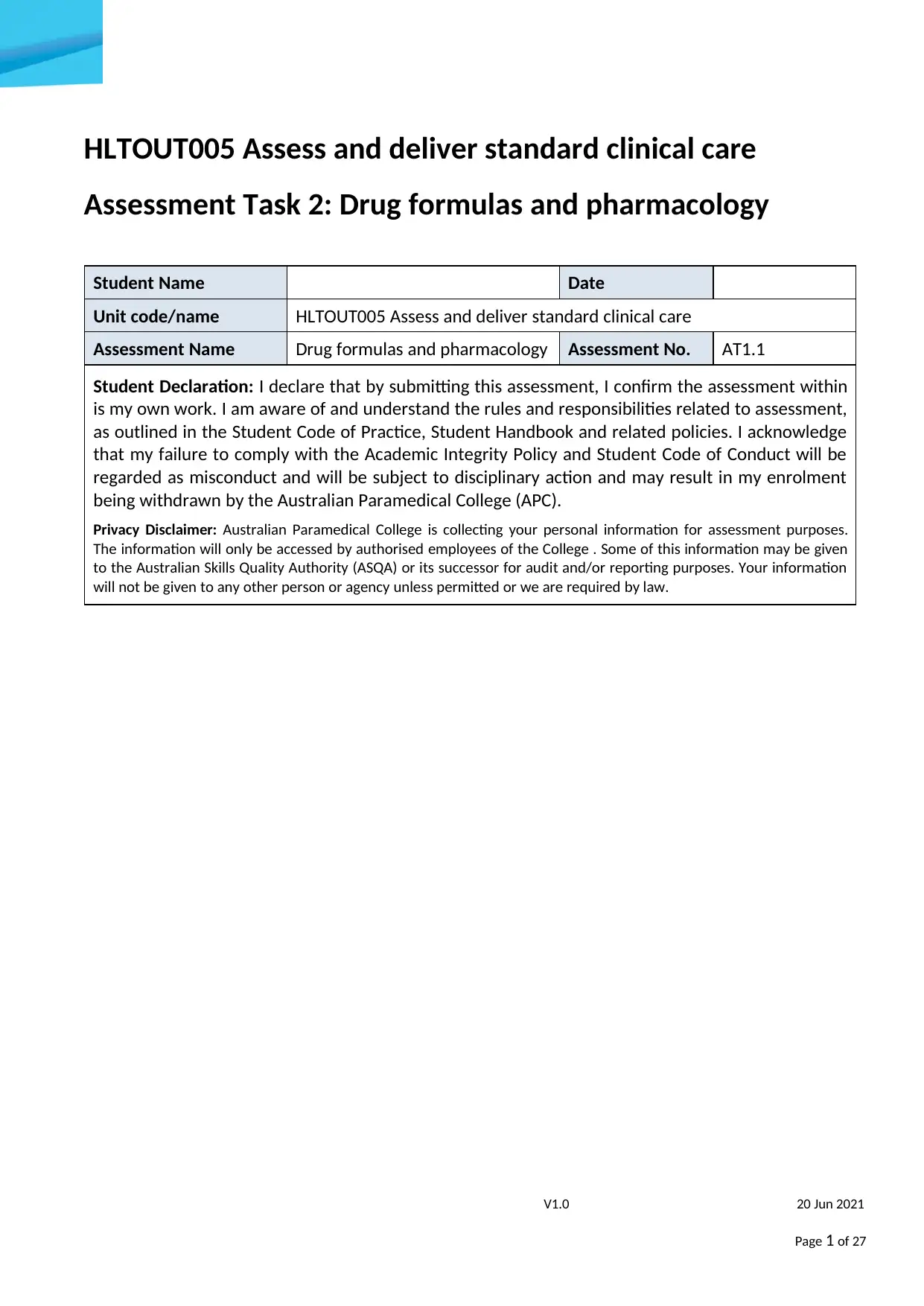
V1.0 20 Jun 2021
Page 1 of 27
HLTOUT005 Assess and deliver standard clinical care
Assessment Task 2: Drug formulas and pharmacology
Student Name Date
Unit code/name HLTOUT005 Assess and deliver standard clinical care
Assessment Name Drug formulas and pharmacology Assessment No. AT1.1
Student Declaration: I declare that by submitting this assessment, I confirm the assessment within
is my own work. I am aware of and understand the rules and responsibilities related to assessment,
as outlined in the Student Code of Practice, Student Handbook and related policies. I acknowledge
that my failure to comply with the Academic Integrity Policy and Student Code of Conduct will be
regarded as misconduct and will be subject to disciplinary action and may result in my enrolment
being withdrawn by the Australian Paramedical College (APC).
Privacy Disclaimer: Australian Paramedical College is collecting your personal information for assessment purposes.
The information will only be accessed by authorised employees of the College . Some of this information may be given
to the Australian Skills Quality Authority (ASQA) or its successor for audit and/or reporting purposes. Your information
will not be given to any other person or agency unless permitted or we are required by law.
Page 1 of 27
HLTOUT005 Assess and deliver standard clinical care
Assessment Task 2: Drug formulas and pharmacology
Student Name Date
Unit code/name HLTOUT005 Assess and deliver standard clinical care
Assessment Name Drug formulas and pharmacology Assessment No. AT1.1
Student Declaration: I declare that by submitting this assessment, I confirm the assessment within
is my own work. I am aware of and understand the rules and responsibilities related to assessment,
as outlined in the Student Code of Practice, Student Handbook and related policies. I acknowledge
that my failure to comply with the Academic Integrity Policy and Student Code of Conduct will be
regarded as misconduct and will be subject to disciplinary action and may result in my enrolment
being withdrawn by the Australian Paramedical College (APC).
Privacy Disclaimer: Australian Paramedical College is collecting your personal information for assessment purposes.
The information will only be accessed by authorised employees of the College . Some of this information may be given
to the Australian Skills Quality Authority (ASQA) or its successor for audit and/or reporting purposes. Your information
will not be given to any other person or agency unless permitted or we are required by law.
Secure Best Marks with AI Grader
Need help grading? Try our AI Grader for instant feedback on your assignments.
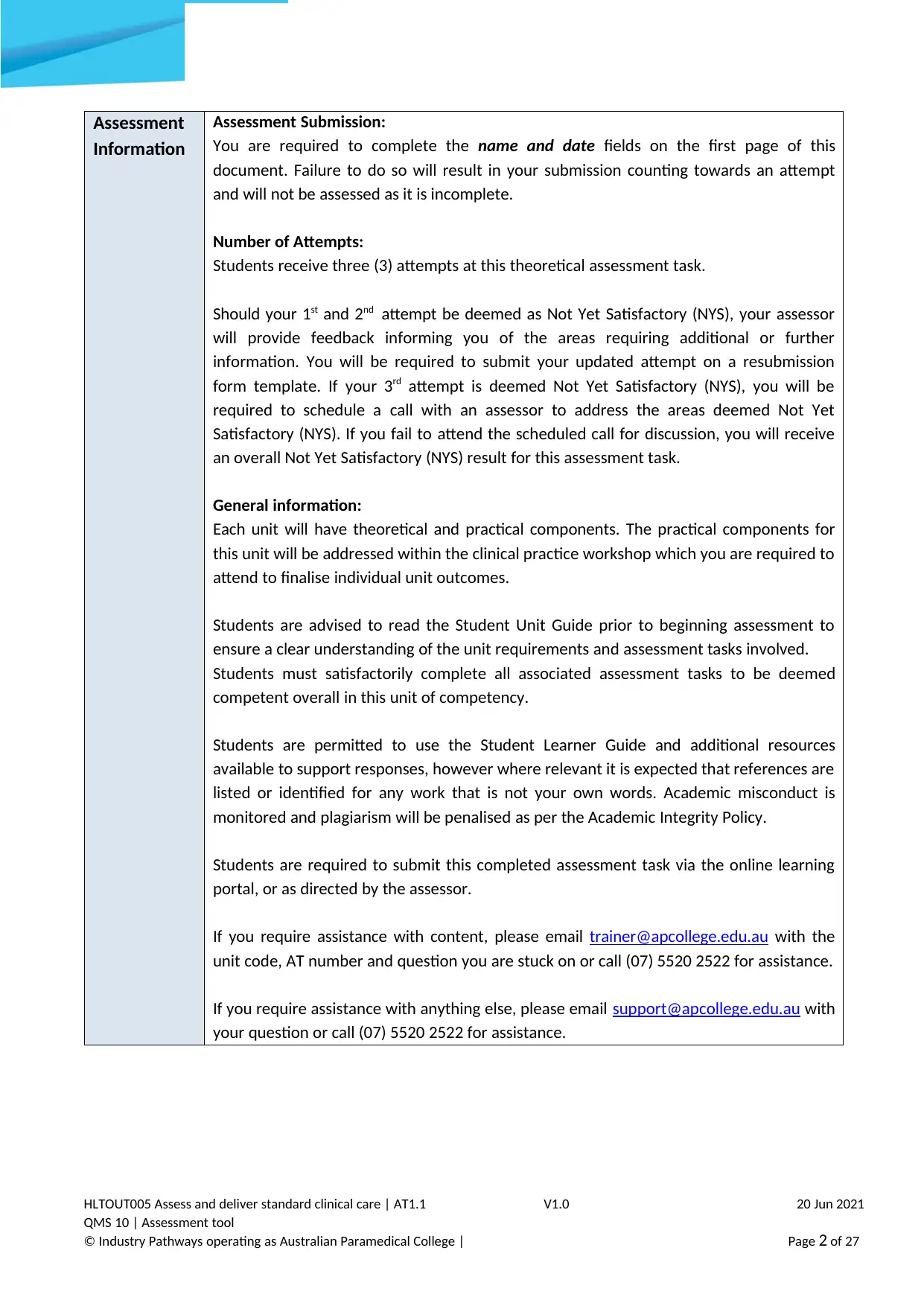
HLTOUT005 Assess and deliver standard clinical care | AT1.1
QMS 10 | Assessment tool
© Industry Pathways operating as Australian Paramedical College |
RTO32513
V1.0 20 Jun 2021
Page 2 of 27
Assessment
Information
Assessment Submission:
You are required to complete the name and date fields on the first page of this
document. Failure to do so will result in your submission counting towards an attempt
and will not be assessed as it is incomplete.
Number of Attempts:
Students receive three (3) attempts at this theoretical assessment task.
Should your 1st and 2nd attempt be deemed as Not Yet Satisfactory (NYS), your assessor
will provide feedback informing you of the areas requiring additional or further
information. You will be required to submit your updated attempt on a resubmission
form template. If your 3rd attempt is deemed Not Yet Satisfactory (NYS), you will be
required to schedule a call with an assessor to address the areas deemed Not Yet
Satisfactory (NYS). If you fail to attend the scheduled call for discussion, you will receive
an overall Not Yet Satisfactory (NYS) result for this assessment task.
General information:
Each unit will have theoretical and practical components. The practical components for
this unit will be addressed within the clinical practice workshop which you are required to
attend to finalise individual unit outcomes.
Students are advised to read the Student Unit Guide prior to beginning assessment to
ensure a clear understanding of the unit requirements and assessment tasks involved.
Students must satisfactorily complete all associated assessment tasks to be deemed
competent overall in this unit of competency.
Students are permitted to use the Student Learner Guide and additional resources
available to support responses, however where relevant it is expected that references are
listed or identified for any work that is not your own words. Academic misconduct is
monitored and plagiarism will be penalised as per the Academic Integrity Policy.
Students are required to submit this completed assessment task via the online learning
portal, or as directed by the assessor.
If you require assistance with content, please email trainer@apcollege.edu.au with the
unit code, AT number and question you are stuck on or call (07) 5520 2522 for assistance.
If you require assistance with anything else, please email support@apcollege.edu.au with
your question or call (07) 5520 2522 for assistance.
QMS 10 | Assessment tool
© Industry Pathways operating as Australian Paramedical College |
RTO32513
V1.0 20 Jun 2021
Page 2 of 27
Assessment
Information
Assessment Submission:
You are required to complete the name and date fields on the first page of this
document. Failure to do so will result in your submission counting towards an attempt
and will not be assessed as it is incomplete.
Number of Attempts:
Students receive three (3) attempts at this theoretical assessment task.
Should your 1st and 2nd attempt be deemed as Not Yet Satisfactory (NYS), your assessor
will provide feedback informing you of the areas requiring additional or further
information. You will be required to submit your updated attempt on a resubmission
form template. If your 3rd attempt is deemed Not Yet Satisfactory (NYS), you will be
required to schedule a call with an assessor to address the areas deemed Not Yet
Satisfactory (NYS). If you fail to attend the scheduled call for discussion, you will receive
an overall Not Yet Satisfactory (NYS) result for this assessment task.
General information:
Each unit will have theoretical and practical components. The practical components for
this unit will be addressed within the clinical practice workshop which you are required to
attend to finalise individual unit outcomes.
Students are advised to read the Student Unit Guide prior to beginning assessment to
ensure a clear understanding of the unit requirements and assessment tasks involved.
Students must satisfactorily complete all associated assessment tasks to be deemed
competent overall in this unit of competency.
Students are permitted to use the Student Learner Guide and additional resources
available to support responses, however where relevant it is expected that references are
listed or identified for any work that is not your own words. Academic misconduct is
monitored and plagiarism will be penalised as per the Academic Integrity Policy.
Students are required to submit this completed assessment task via the online learning
portal, or as directed by the assessor.
If you require assistance with content, please email trainer@apcollege.edu.au with the
unit code, AT number and question you are stuck on or call (07) 5520 2522 for assistance.
If you require assistance with anything else, please email support@apcollege.edu.au with
your question or call (07) 5520 2522 for assistance.
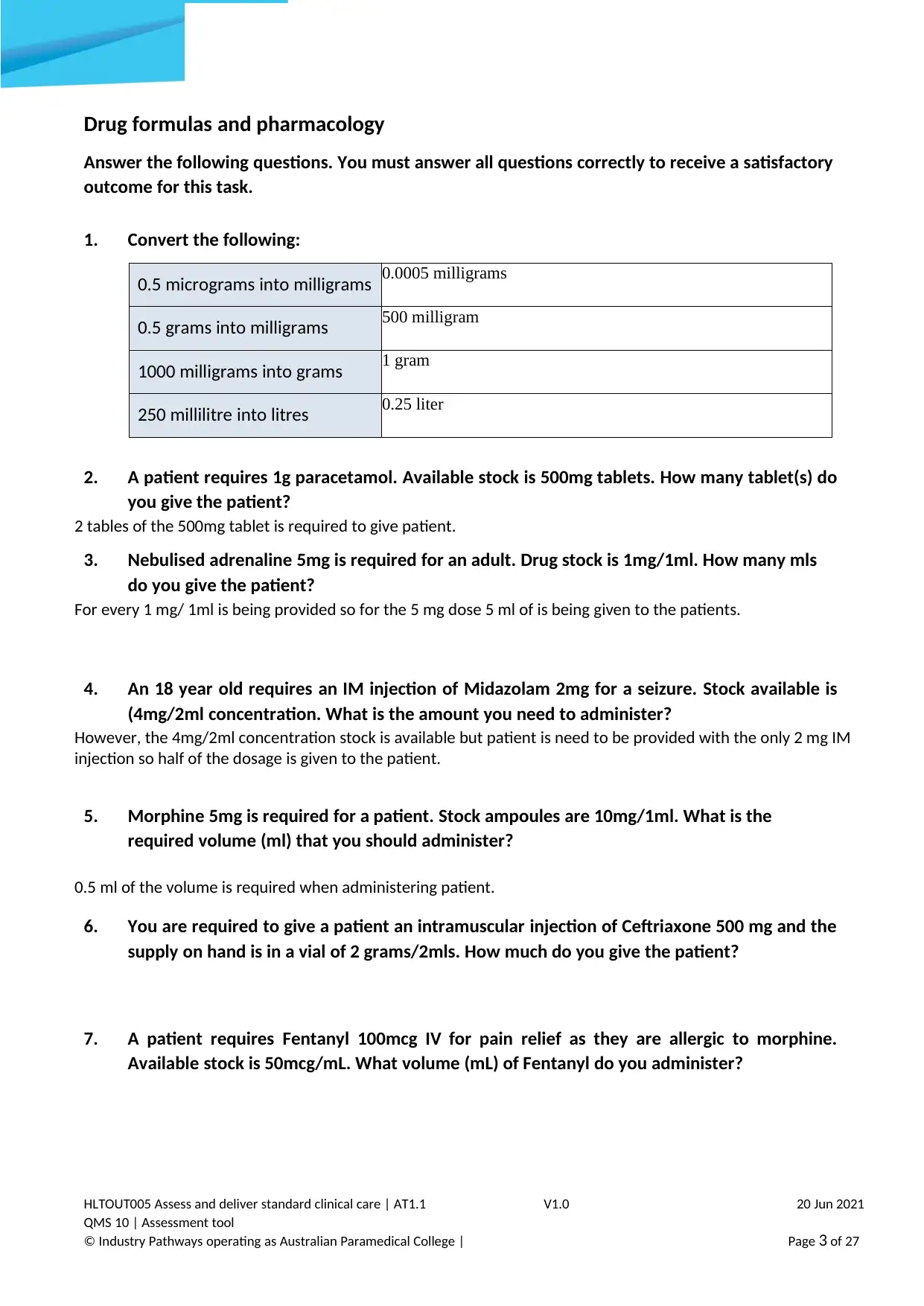
HLTOUT005 Assess and deliver standard clinical care | AT1.1
QMS 10 | Assessment tool
© Industry Pathways operating as Australian Paramedical College |
RTO32513
V1.0 20 Jun 2021
Page 3 of 27
Drug formulas and pharmacology
Answer the following questions. You must answer all questions correctly to receive a satisfactory
outcome for this task.
1. Convert the following:
0.5 micrograms into milligrams 0.0005 milligrams
0.5 grams into milligrams 500 milligram
1000 milligrams into grams 1 gram
250 millilitre into litres 0.25 liter
2. A patient requires 1g paracetamol. Available stock is 500mg tablets. How many tablet(s) do
you give the patient?
2 tables of the 500mg tablet is required to give patient.
3. Nebulised adrenaline 5mg is required for an adult. Drug stock is 1mg/1ml. How many mls
do you give the patient?
For every 1 mg/ 1ml is being provided so for the 5 mg dose 5 ml of is being given to the patients.
4. An 18 year old requires an IM injection of Midazolam 2mg for a seizure. Stock available is
(4mg/2ml concentration. What is the amount you need to administer?
However, the 4mg/2ml concentration stock is available but patient is need to be provided with the only 2 mg IM
injection so half of the dosage is given to the patient.
5. Morphine 5mg is required for a patient. Stock ampoules are 10mg/1ml. What is the
required volume (ml) that you should administer?
0.5 ml of the volume is required when administering patient.
6. You are required to give a patient an intramuscular injection of Ceftriaxone 500 mg and the
supply on hand is in a vial of 2 grams/2mls. How much do you give the patient?
7. A patient requires Fentanyl 100mcg IV for pain relief as they are allergic to morphine.
Available stock is 50mcg/mL. What volume (mL) of Fentanyl do you administer?
QMS 10 | Assessment tool
© Industry Pathways operating as Australian Paramedical College |
RTO32513
V1.0 20 Jun 2021
Page 3 of 27
Drug formulas and pharmacology
Answer the following questions. You must answer all questions correctly to receive a satisfactory
outcome for this task.
1. Convert the following:
0.5 micrograms into milligrams 0.0005 milligrams
0.5 grams into milligrams 500 milligram
1000 milligrams into grams 1 gram
250 millilitre into litres 0.25 liter
2. A patient requires 1g paracetamol. Available stock is 500mg tablets. How many tablet(s) do
you give the patient?
2 tables of the 500mg tablet is required to give patient.
3. Nebulised adrenaline 5mg is required for an adult. Drug stock is 1mg/1ml. How many mls
do you give the patient?
For every 1 mg/ 1ml is being provided so for the 5 mg dose 5 ml of is being given to the patients.
4. An 18 year old requires an IM injection of Midazolam 2mg for a seizure. Stock available is
(4mg/2ml concentration. What is the amount you need to administer?
However, the 4mg/2ml concentration stock is available but patient is need to be provided with the only 2 mg IM
injection so half of the dosage is given to the patient.
5. Morphine 5mg is required for a patient. Stock ampoules are 10mg/1ml. What is the
required volume (ml) that you should administer?
0.5 ml of the volume is required when administering patient.
6. You are required to give a patient an intramuscular injection of Ceftriaxone 500 mg and the
supply on hand is in a vial of 2 grams/2mls. How much do you give the patient?
7. A patient requires Fentanyl 100mcg IV for pain relief as they are allergic to morphine.
Available stock is 50mcg/mL. What volume (mL) of Fentanyl do you administer?
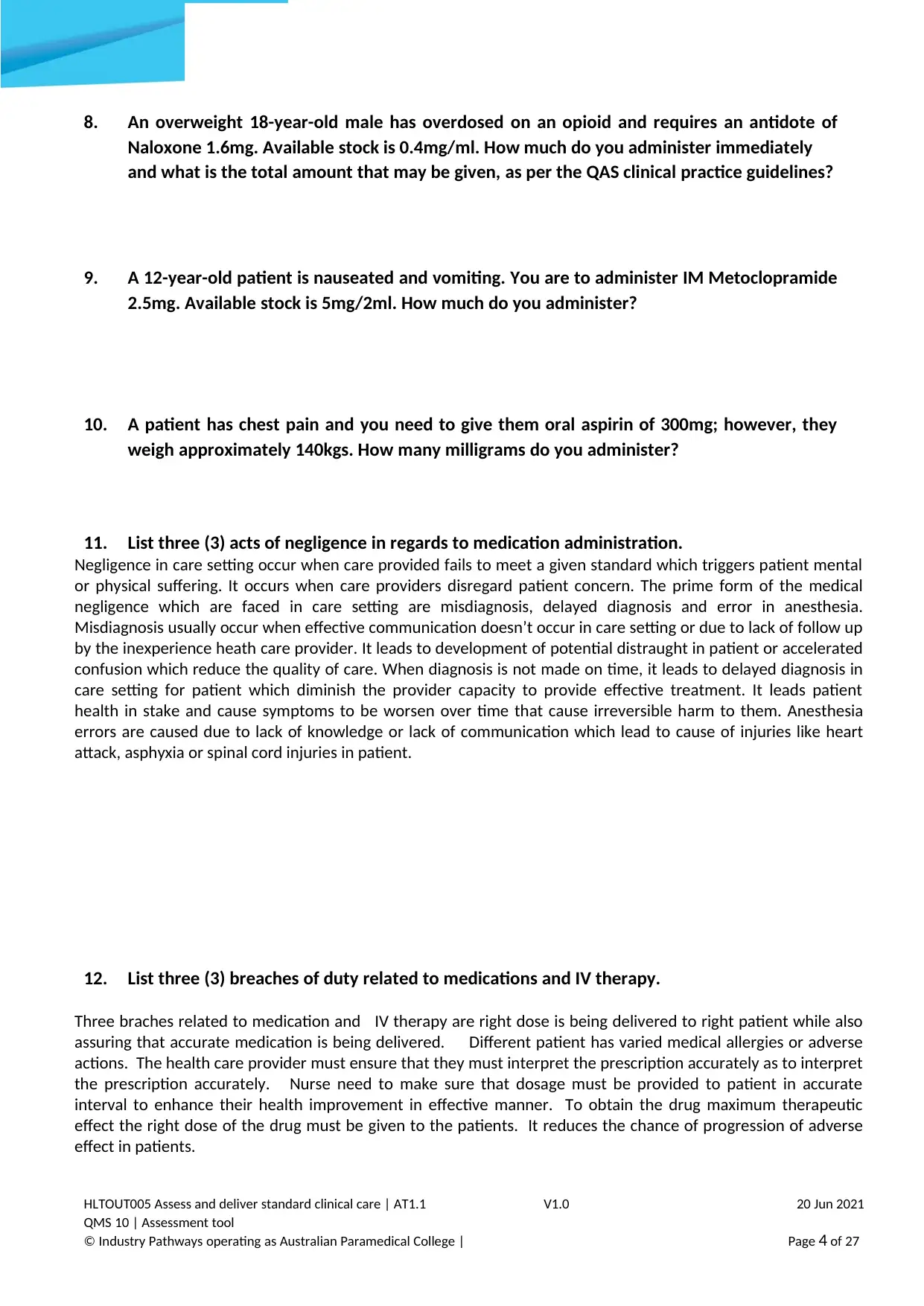
HLTOUT005 Assess and deliver standard clinical care | AT1.1
QMS 10 | Assessment tool
© Industry Pathways operating as Australian Paramedical College |
RTO32513
V1.0 20 Jun 2021
Page 4 of 27
8. An overweight 18-year-old male has overdosed on an opioid and requires an antidote of
Naloxone 1.6mg. Available stock is 0.4mg/ml. How much do you administer immediately
and what is the total amount that may be given, as per the QAS clinical practice guidelines?
9. A 12-year-old patient is nauseated and vomiting. You are to administer IM Metoclopramide
2.5mg. Available stock is 5mg/2ml. How much do you administer?
10. A patient has chest pain and you need to give them oral aspirin of 300mg; however, they
weigh approximately 140kgs. How many milligrams do you administer?
11. List three (3) acts of negligence in regards to medication administration.
Negligence in care setting occur when care provided fails to meet a given standard which triggers patient mental
or physical suffering. It occurs when care providers disregard patient concern. The prime form of the medical
negligence which are faced in care setting are misdiagnosis, delayed diagnosis and error in anesthesia.
Misdiagnosis usually occur when effective communication doesn’t occur in care setting or due to lack of follow up
by the inexperience heath care provider. It leads to development of potential distraught in patient or accelerated
confusion which reduce the quality of care. When diagnosis is not made on time, it leads to delayed diagnosis in
care setting for patient which diminish the provider capacity to provide effective treatment. It leads patient
health in stake and cause symptoms to be worsen over time that cause irreversible harm to them. Anesthesia
errors are caused due to lack of knowledge or lack of communication which lead to cause of injuries like heart
attack, asphyxia or spinal cord injuries in patient.
12. List three (3) breaches of duty related to medications and IV therapy.
Three braches related to medication and IV therapy are right dose is being delivered to right patient while also
assuring that accurate medication is being delivered. Different patient has varied medical allergies or adverse
actions. The health care provider must ensure that they must interpret the prescription accurately as to interpret
the prescription accurately. Nurse need to make sure that dosage must be provided to patient in accurate
interval to enhance their health improvement in effective manner. To obtain the drug maximum therapeutic
effect the right dose of the drug must be given to the patients. It reduces the chance of progression of adverse
effect in patients.
QMS 10 | Assessment tool
© Industry Pathways operating as Australian Paramedical College |
RTO32513
V1.0 20 Jun 2021
Page 4 of 27
8. An overweight 18-year-old male has overdosed on an opioid and requires an antidote of
Naloxone 1.6mg. Available stock is 0.4mg/ml. How much do you administer immediately
and what is the total amount that may be given, as per the QAS clinical practice guidelines?
9. A 12-year-old patient is nauseated and vomiting. You are to administer IM Metoclopramide
2.5mg. Available stock is 5mg/2ml. How much do you administer?
10. A patient has chest pain and you need to give them oral aspirin of 300mg; however, they
weigh approximately 140kgs. How many milligrams do you administer?
11. List three (3) acts of negligence in regards to medication administration.
Negligence in care setting occur when care provided fails to meet a given standard which triggers patient mental
or physical suffering. It occurs when care providers disregard patient concern. The prime form of the medical
negligence which are faced in care setting are misdiagnosis, delayed diagnosis and error in anesthesia.
Misdiagnosis usually occur when effective communication doesn’t occur in care setting or due to lack of follow up
by the inexperience heath care provider. It leads to development of potential distraught in patient or accelerated
confusion which reduce the quality of care. When diagnosis is not made on time, it leads to delayed diagnosis in
care setting for patient which diminish the provider capacity to provide effective treatment. It leads patient
health in stake and cause symptoms to be worsen over time that cause irreversible harm to them. Anesthesia
errors are caused due to lack of knowledge or lack of communication which lead to cause of injuries like heart
attack, asphyxia or spinal cord injuries in patient.
12. List three (3) breaches of duty related to medications and IV therapy.
Three braches related to medication and IV therapy are right dose is being delivered to right patient while also
assuring that accurate medication is being delivered. Different patient has varied medical allergies or adverse
actions. The health care provider must ensure that they must interpret the prescription accurately as to interpret
the prescription accurately. Nurse need to make sure that dosage must be provided to patient in accurate
interval to enhance their health improvement in effective manner. To obtain the drug maximum therapeutic
effect the right dose of the drug must be given to the patients. It reduces the chance of progression of adverse
effect in patients.
Secure Best Marks with AI Grader
Need help grading? Try our AI Grader for instant feedback on your assignments.
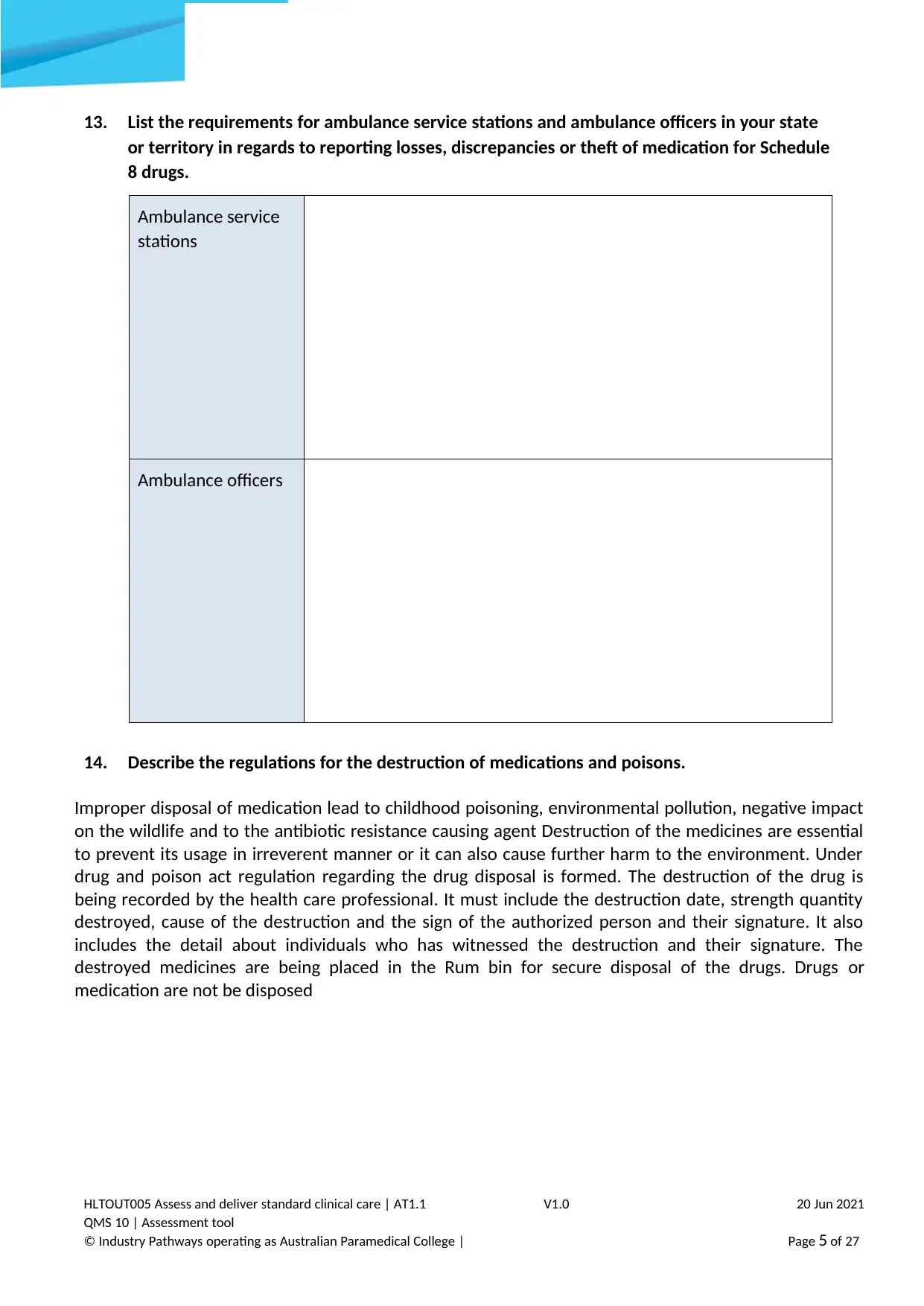
HLTOUT005 Assess and deliver standard clinical care | AT1.1
QMS 10 | Assessment tool
© Industry Pathways operating as Australian Paramedical College |
RTO32513
V1.0 20 Jun 2021
Page 5 of 27
13. List the requirements for ambulance service stations and ambulance officers in your state
or territory in regards to reporting losses, discrepancies or theft of medication for Schedule
8 drugs.
Ambulance service
stations
Ambulance officers
14. Describe the regulations for the destruction of medications and poisons.
Improper disposal of medication lead to childhood poisoning, environmental pollution, negative impact
on the wildlife and to the antibiotic resistance causing agent Destruction of the medicines are essential
to prevent its usage in irreverent manner or it can also cause further harm to the environment. Under
drug and poison act regulation regarding the drug disposal is formed. The destruction of the drug is
being recorded by the health care professional. It must include the destruction date, strength quantity
destroyed, cause of the destruction and the sign of the authorized person and their signature. It also
includes the detail about individuals who has witnessed the destruction and their signature. The
destroyed medicines are being placed in the Rum bin for secure disposal of the drugs. Drugs or
medication are not be disposed
QMS 10 | Assessment tool
© Industry Pathways operating as Australian Paramedical College |
RTO32513
V1.0 20 Jun 2021
Page 5 of 27
13. List the requirements for ambulance service stations and ambulance officers in your state
or territory in regards to reporting losses, discrepancies or theft of medication for Schedule
8 drugs.
Ambulance service
stations
Ambulance officers
14. Describe the regulations for the destruction of medications and poisons.
Improper disposal of medication lead to childhood poisoning, environmental pollution, negative impact
on the wildlife and to the antibiotic resistance causing agent Destruction of the medicines are essential
to prevent its usage in irreverent manner or it can also cause further harm to the environment. Under
drug and poison act regulation regarding the drug disposal is formed. The destruction of the drug is
being recorded by the health care professional. It must include the destruction date, strength quantity
destroyed, cause of the destruction and the sign of the authorized person and their signature. It also
includes the detail about individuals who has witnessed the destruction and their signature. The
destroyed medicines are being placed in the Rum bin for secure disposal of the drugs. Drugs or
medication are not be disposed
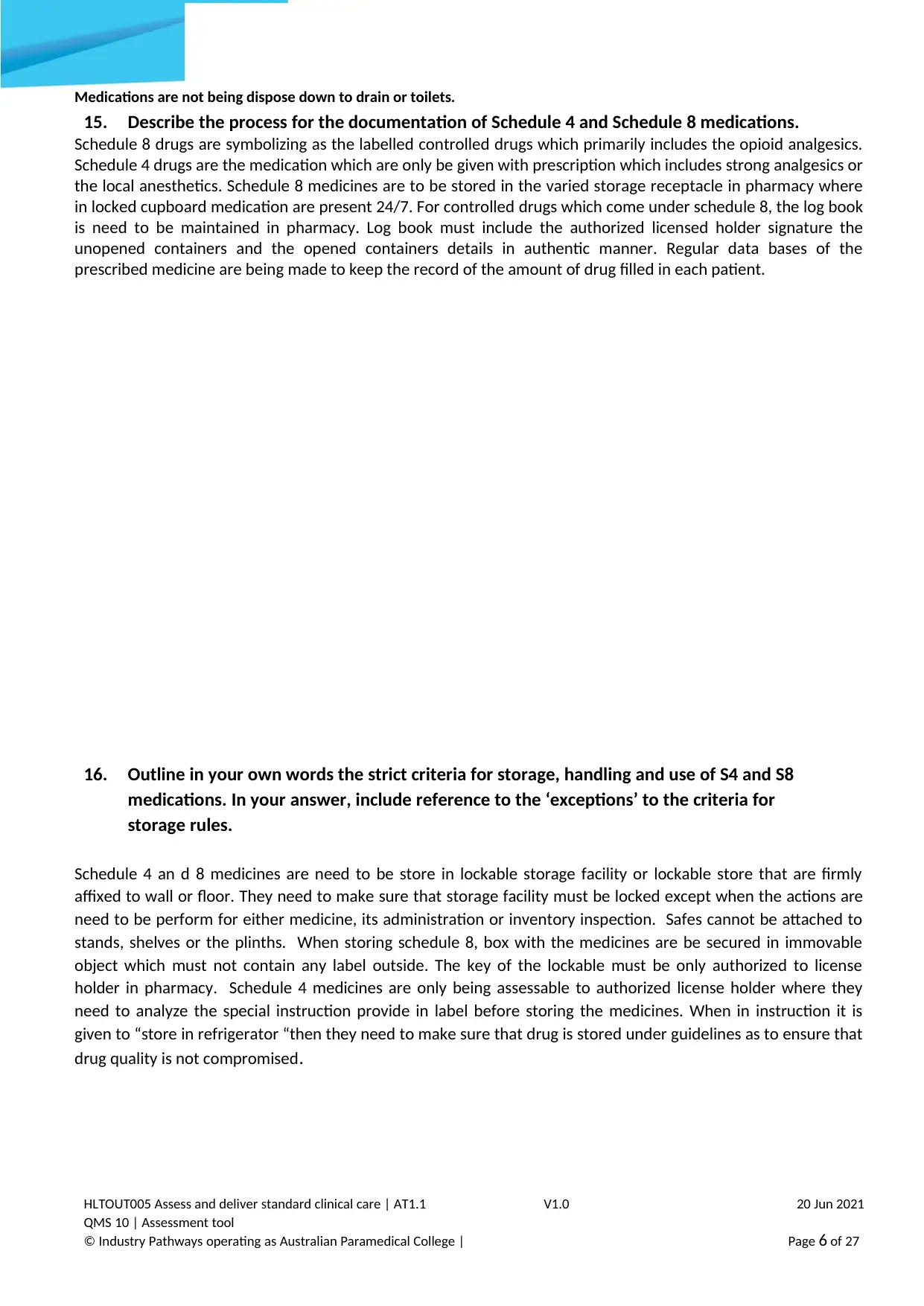
HLTOUT005 Assess and deliver standard clinical care | AT1.1
QMS 10 | Assessment tool
© Industry Pathways operating as Australian Paramedical College |
RTO32513
V1.0 20 Jun 2021
Page 6 of 27
Medications are not being dispose down to drain or toilets.
15. Describe the process for the documentation of Schedule 4 and Schedule 8 medications.
Schedule 8 drugs are symbolizing as the labelled controlled drugs which primarily includes the opioid analgesics.
Schedule 4 drugs are the medication which are only be given with prescription which includes strong analgesics or
the local anesthetics. Schedule 8 medicines are to be stored in the varied storage receptacle in pharmacy where
in locked cupboard medication are present 24/7. For controlled drugs which come under schedule 8, the log book
is need to be maintained in pharmacy. Log book must include the authorized licensed holder signature the
unopened containers and the opened containers details in authentic manner. Regular data bases of the
prescribed medicine are being made to keep the record of the amount of drug filled in each patient.
16. Outline in your own words the strict criteria for storage, handling and use of S4 and S8
medications. In your answer, include reference to the ‘exceptions’ to the criteria for
storage rules.
Schedule 4 an d 8 medicines are need to be store in lockable storage facility or lockable store that are firmly
affixed to wall or floor. They need to make sure that storage facility must be locked except when the actions are
need to be perform for either medicine, its administration or inventory inspection. Safes cannot be attached to
stands, shelves or the plinths. When storing schedule 8, box with the medicines are be secured in immovable
object which must not contain any label outside. The key of the lockable must be only authorized to license
holder in pharmacy. Schedule 4 medicines are only being assessable to authorized license holder where they
need to analyze the special instruction provide in label before storing the medicines. When in instruction it is
given to “store in refrigerator “then they need to make sure that drug is stored under guidelines as to ensure that
drug quality is not compromised.
QMS 10 | Assessment tool
© Industry Pathways operating as Australian Paramedical College |
RTO32513
V1.0 20 Jun 2021
Page 6 of 27
Medications are not being dispose down to drain or toilets.
15. Describe the process for the documentation of Schedule 4 and Schedule 8 medications.
Schedule 8 drugs are symbolizing as the labelled controlled drugs which primarily includes the opioid analgesics.
Schedule 4 drugs are the medication which are only be given with prescription which includes strong analgesics or
the local anesthetics. Schedule 8 medicines are to be stored in the varied storage receptacle in pharmacy where
in locked cupboard medication are present 24/7. For controlled drugs which come under schedule 8, the log book
is need to be maintained in pharmacy. Log book must include the authorized licensed holder signature the
unopened containers and the opened containers details in authentic manner. Regular data bases of the
prescribed medicine are being made to keep the record of the amount of drug filled in each patient.
16. Outline in your own words the strict criteria for storage, handling and use of S4 and S8
medications. In your answer, include reference to the ‘exceptions’ to the criteria for
storage rules.
Schedule 4 an d 8 medicines are need to be store in lockable storage facility or lockable store that are firmly
affixed to wall or floor. They need to make sure that storage facility must be locked except when the actions are
need to be perform for either medicine, its administration or inventory inspection. Safes cannot be attached to
stands, shelves or the plinths. When storing schedule 8, box with the medicines are be secured in immovable
object which must not contain any label outside. The key of the lockable must be only authorized to license
holder in pharmacy. Schedule 4 medicines are only being assessable to authorized license holder where they
need to analyze the special instruction provide in label before storing the medicines. When in instruction it is
given to “store in refrigerator “then they need to make sure that drug is stored under guidelines as to ensure that
drug quality is not compromised.
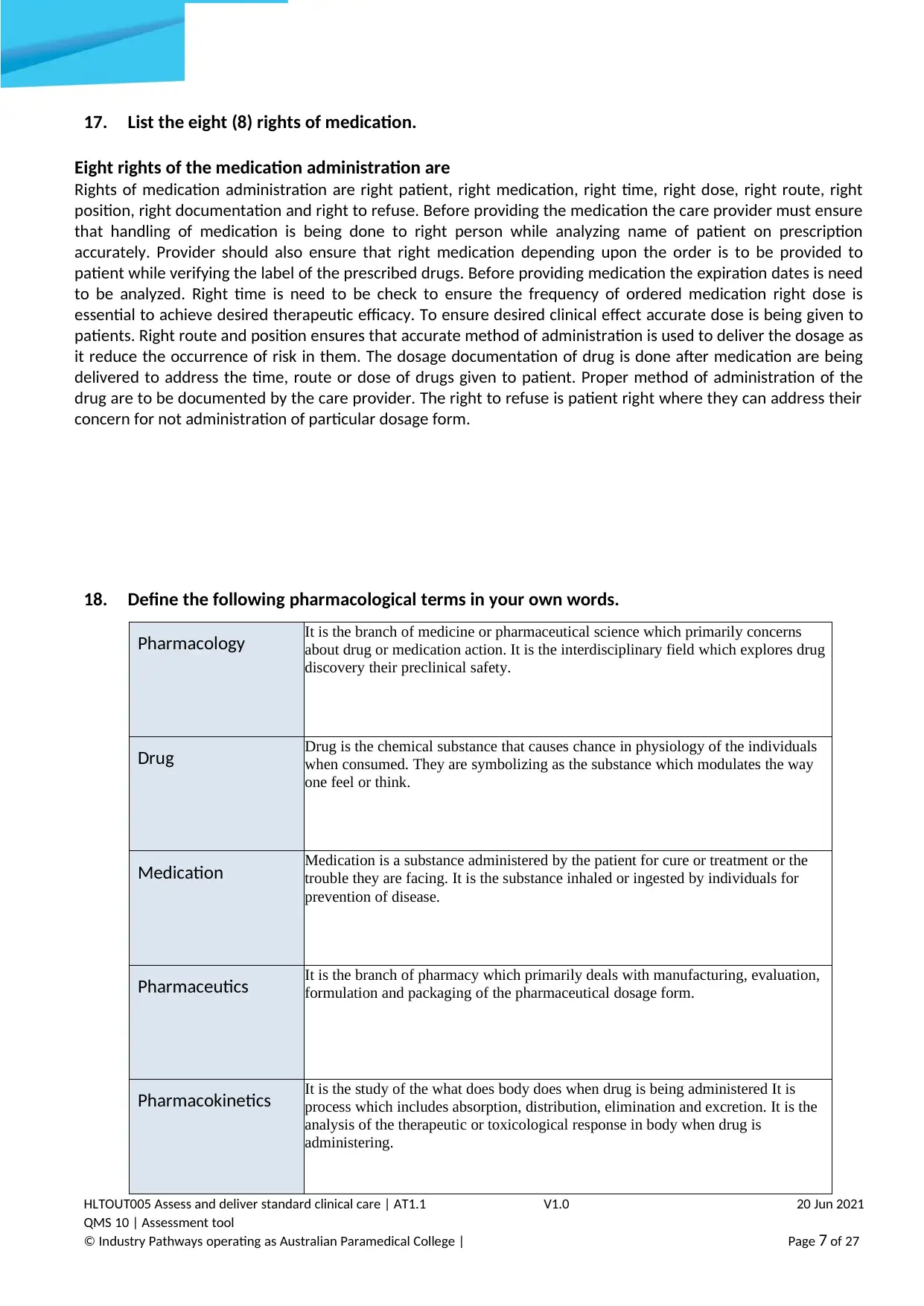
HLTOUT005 Assess and deliver standard clinical care | AT1.1
QMS 10 | Assessment tool
© Industry Pathways operating as Australian Paramedical College |
RTO32513
V1.0 20 Jun 2021
Page 7 of 27
17. List the eight (8) rights of medication.
Eight rights of the medication administration are
Rights of medication administration are right patient, right medication, right time, right dose, right route, right
position, right documentation and right to refuse. Before providing the medication the care provider must ensure
that handling of medication is being done to right person while analyzing name of patient on prescription
accurately. Provider should also ensure that right medication depending upon the order is to be provided to
patient while verifying the label of the prescribed drugs. Before providing medication the expiration dates is need
to be analyzed. Right time is need to be check to ensure the frequency of ordered medication right dose is
essential to achieve desired therapeutic efficacy. To ensure desired clinical effect accurate dose is being given to
patients. Right route and position ensures that accurate method of administration is used to deliver the dosage as
it reduce the occurrence of risk in them. The dosage documentation of drug is done after medication are being
delivered to address the time, route or dose of drugs given to patient. Proper method of administration of the
drug are to be documented by the care provider. The right to refuse is patient right where they can address their
concern for not administration of particular dosage form.
18. Define the following pharmacological terms in your own words.
Pharmacology It is the branch of medicine or pharmaceutical science which primarily concerns
about drug or medication action. It is the interdisciplinary field which explores drug
discovery their preclinical safety.
Drug Drug is the chemical substance that causes chance in physiology of the individuals
when consumed. They are symbolizing as the substance which modulates the way
one feel or think.
Medication Medication is a substance administered by the patient for cure or treatment or the
trouble they are facing. It is the substance inhaled or ingested by individuals for
prevention of disease.
Pharmaceutics It is the branch of pharmacy which primarily deals with manufacturing, evaluation,
formulation and packaging of the pharmaceutical dosage form.
Pharmacokinetics It is the study of the what does body does when drug is being administered It is
process which includes absorption, distribution, elimination and excretion. It is the
analysis of the therapeutic or toxicological response in body when drug is
administering.
QMS 10 | Assessment tool
© Industry Pathways operating as Australian Paramedical College |
RTO32513
V1.0 20 Jun 2021
Page 7 of 27
17. List the eight (8) rights of medication.
Eight rights of the medication administration are
Rights of medication administration are right patient, right medication, right time, right dose, right route, right
position, right documentation and right to refuse. Before providing the medication the care provider must ensure
that handling of medication is being done to right person while analyzing name of patient on prescription
accurately. Provider should also ensure that right medication depending upon the order is to be provided to
patient while verifying the label of the prescribed drugs. Before providing medication the expiration dates is need
to be analyzed. Right time is need to be check to ensure the frequency of ordered medication right dose is
essential to achieve desired therapeutic efficacy. To ensure desired clinical effect accurate dose is being given to
patients. Right route and position ensures that accurate method of administration is used to deliver the dosage as
it reduce the occurrence of risk in them. The dosage documentation of drug is done after medication are being
delivered to address the time, route or dose of drugs given to patient. Proper method of administration of the
drug are to be documented by the care provider. The right to refuse is patient right where they can address their
concern for not administration of particular dosage form.
18. Define the following pharmacological terms in your own words.
Pharmacology It is the branch of medicine or pharmaceutical science which primarily concerns
about drug or medication action. It is the interdisciplinary field which explores drug
discovery their preclinical safety.
Drug Drug is the chemical substance that causes chance in physiology of the individuals
when consumed. They are symbolizing as the substance which modulates the way
one feel or think.
Medication Medication is a substance administered by the patient for cure or treatment or the
trouble they are facing. It is the substance inhaled or ingested by individuals for
prevention of disease.
Pharmaceutics It is the branch of pharmacy which primarily deals with manufacturing, evaluation,
formulation and packaging of the pharmaceutical dosage form.
Pharmacokinetics It is the study of the what does body does when drug is being administered It is
process which includes absorption, distribution, elimination and excretion. It is the
analysis of the therapeutic or toxicological response in body when drug is
administering.
Paraphrase This Document
Need a fresh take? Get an instant paraphrase of this document with our AI Paraphraser
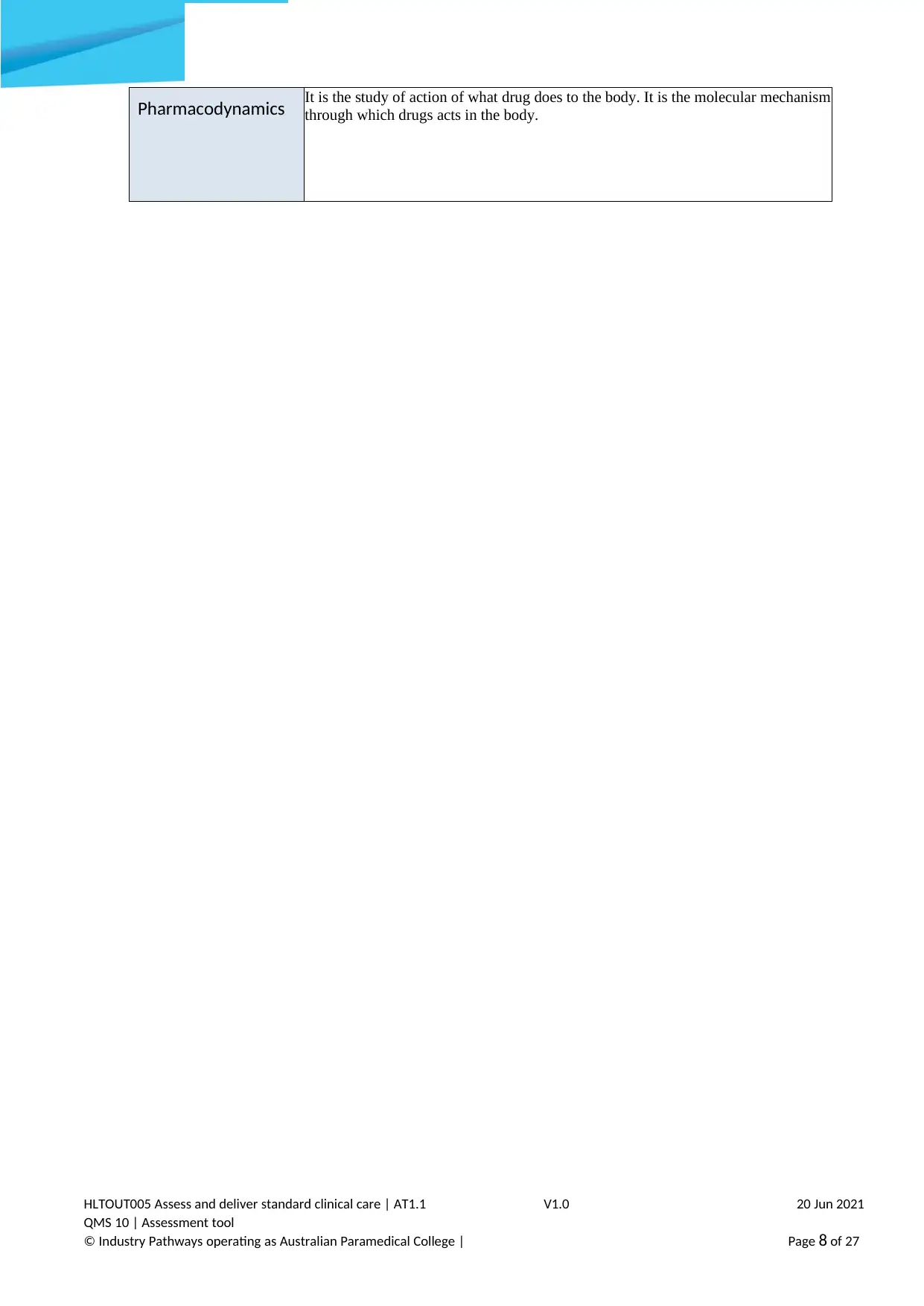
HLTOUT005 Assess and deliver standard clinical care | AT1.1
QMS 10 | Assessment tool
© Industry Pathways operating as Australian Paramedical College |
RTO32513
V1.0 20 Jun 2021
Page 8 of 27
Pharmacodynamics It is the study of action of what drug does to the body. It is the molecular mechanism
through which drugs acts in the body.
QMS 10 | Assessment tool
© Industry Pathways operating as Australian Paramedical College |
RTO32513
V1.0 20 Jun 2021
Page 8 of 27
Pharmacodynamics It is the study of action of what drug does to the body. It is the molecular mechanism
through which drugs acts in the body.
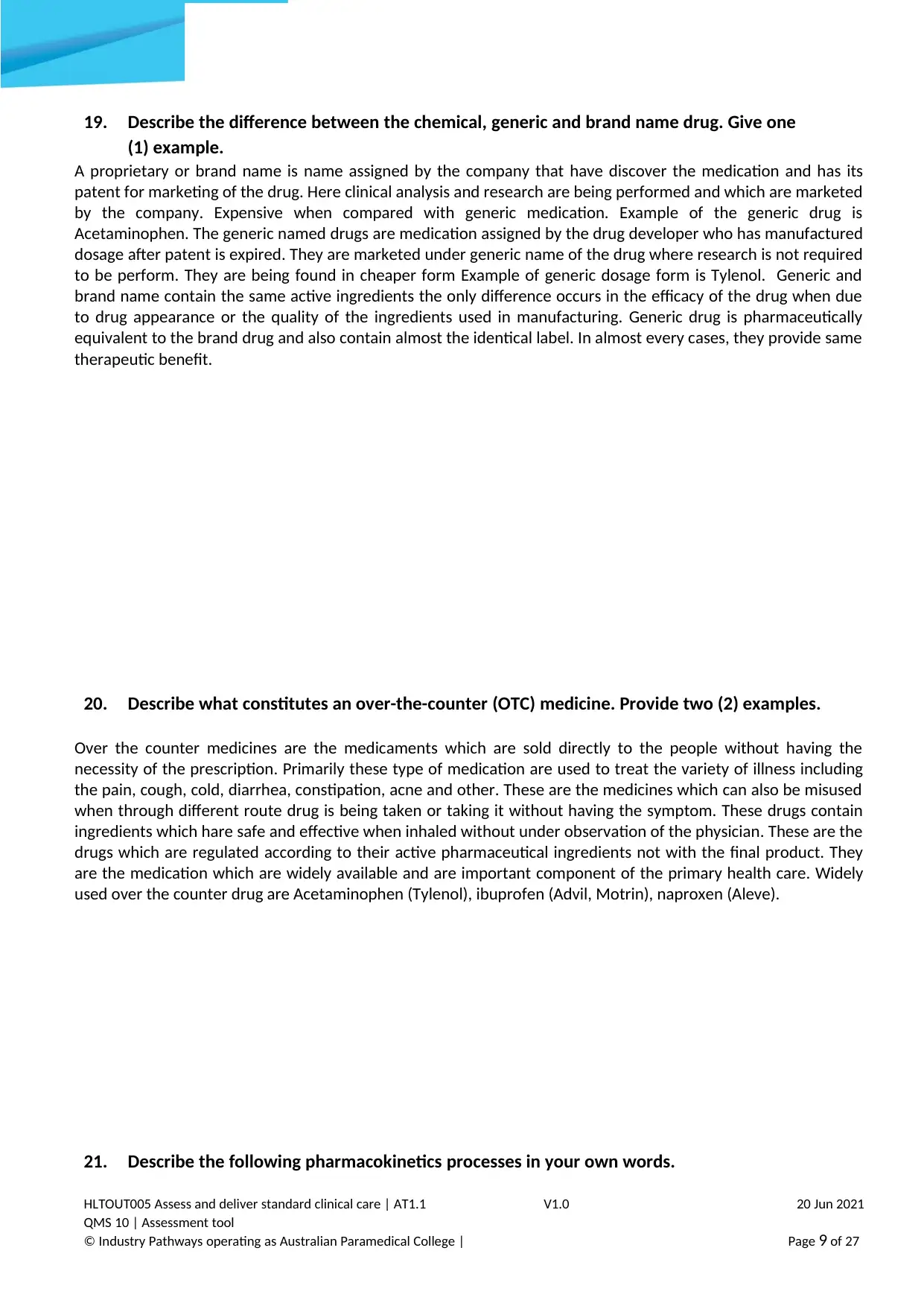
HLTOUT005 Assess and deliver standard clinical care | AT1.1
QMS 10 | Assessment tool
© Industry Pathways operating as Australian Paramedical College |
RTO32513
V1.0 20 Jun 2021
Page 9 of 27
19. Describe the difference between the chemical, generic and brand name drug. Give one
(1) example.
A proprietary or brand name is name assigned by the company that have discover the medication and has its
patent for marketing of the drug. Here clinical analysis and research are being performed and which are marketed
by the company. Expensive when compared with generic medication. Example of the generic drug is
Acetaminophen. The generic named drugs are medication assigned by the drug developer who has manufactured
dosage after patent is expired. They are marketed under generic name of the drug where research is not required
to be perform. They are being found in cheaper form Example of generic dosage form is Tylenol. Generic and
brand name contain the same active ingredients the only difference occurs in the efficacy of the drug when due
to drug appearance or the quality of the ingredients used in manufacturing. Generic drug is pharmaceutically
equivalent to the brand drug and also contain almost the identical label. In almost every cases, they provide same
therapeutic benefit.
20. Describe what constitutes an over-the-counter (OTC) medicine. Provide two (2) examples.
Over the counter medicines are the medicaments which are sold directly to the people without having the
necessity of the prescription. Primarily these type of medication are used to treat the variety of illness including
the pain, cough, cold, diarrhea, constipation, acne and other. These are the medicines which can also be misused
when through different route drug is being taken or taking it without having the symptom. These drugs contain
ingredients which hare safe and effective when inhaled without under observation of the physician. These are the
drugs which are regulated according to their active pharmaceutical ingredients not with the final product. They
are the medication which are widely available and are important component of the primary health care. Widely
used over the counter drug are Acetaminophen (Tylenol), ibuprofen (Advil, Motrin), naproxen (Aleve).
21. Describe the following pharmacokinetics processes in your own words.
QMS 10 | Assessment tool
© Industry Pathways operating as Australian Paramedical College |
RTO32513
V1.0 20 Jun 2021
Page 9 of 27
19. Describe the difference between the chemical, generic and brand name drug. Give one
(1) example.
A proprietary or brand name is name assigned by the company that have discover the medication and has its
patent for marketing of the drug. Here clinical analysis and research are being performed and which are marketed
by the company. Expensive when compared with generic medication. Example of the generic drug is
Acetaminophen. The generic named drugs are medication assigned by the drug developer who has manufactured
dosage after patent is expired. They are marketed under generic name of the drug where research is not required
to be perform. They are being found in cheaper form Example of generic dosage form is Tylenol. Generic and
brand name contain the same active ingredients the only difference occurs in the efficacy of the drug when due
to drug appearance or the quality of the ingredients used in manufacturing. Generic drug is pharmaceutically
equivalent to the brand drug and also contain almost the identical label. In almost every cases, they provide same
therapeutic benefit.
20. Describe what constitutes an over-the-counter (OTC) medicine. Provide two (2) examples.
Over the counter medicines are the medicaments which are sold directly to the people without having the
necessity of the prescription. Primarily these type of medication are used to treat the variety of illness including
the pain, cough, cold, diarrhea, constipation, acne and other. These are the medicines which can also be misused
when through different route drug is being taken or taking it without having the symptom. These drugs contain
ingredients which hare safe and effective when inhaled without under observation of the physician. These are the
drugs which are regulated according to their active pharmaceutical ingredients not with the final product. They
are the medication which are widely available and are important component of the primary health care. Widely
used over the counter drug are Acetaminophen (Tylenol), ibuprofen (Advil, Motrin), naproxen (Aleve).
21. Describe the following pharmacokinetics processes in your own words.
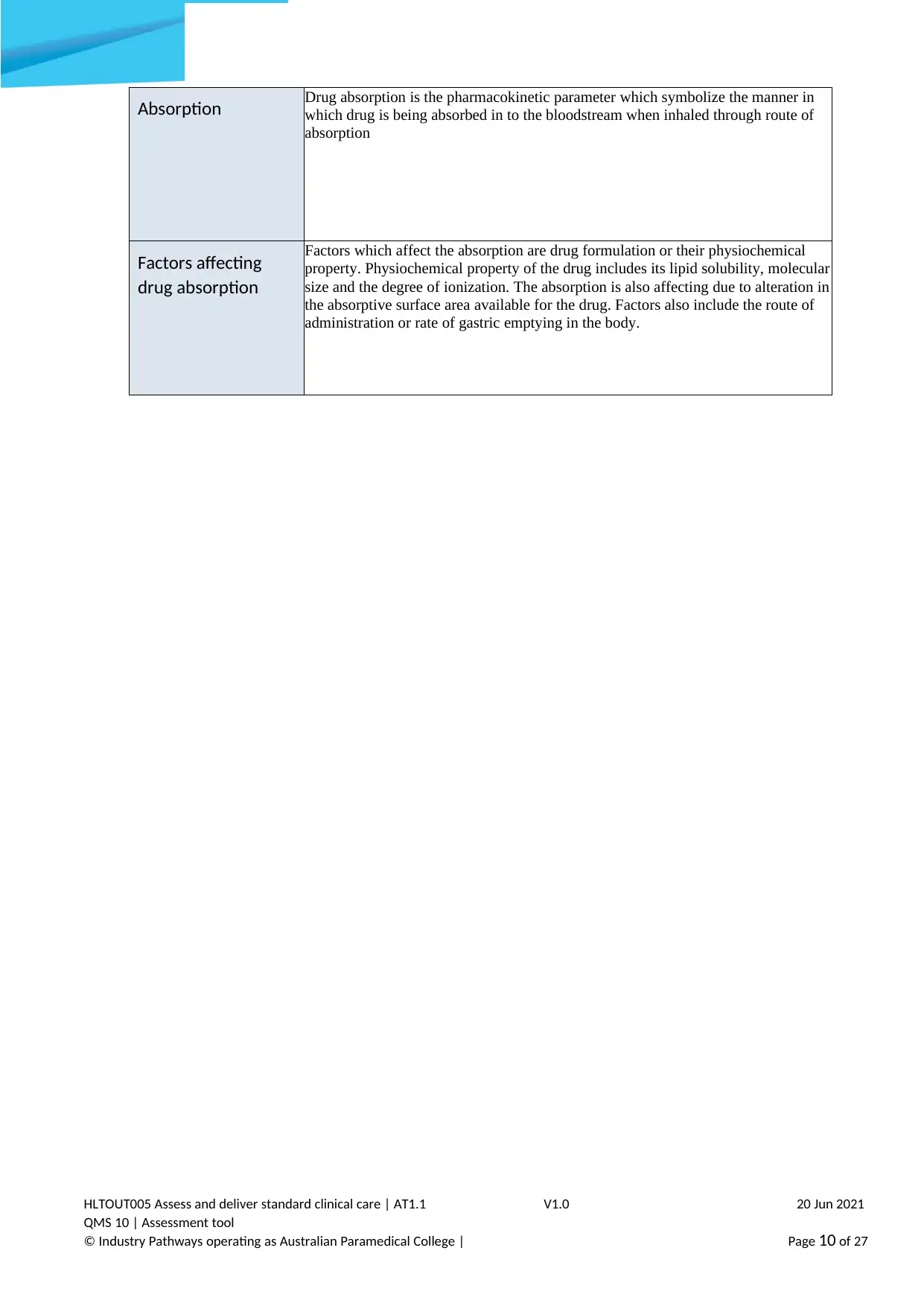
HLTOUT005 Assess and deliver standard clinical care | AT1.1
QMS 10 | Assessment tool
© Industry Pathways operating as Australian Paramedical College |
RTO32513
V1.0 20 Jun 2021
Page 10 of 27
Absorption Drug absorption is the pharmacokinetic parameter which symbolize the manner in
which drug is being absorbed in to the bloodstream when inhaled through route of
absorption
Factors affecting
drug absorption
Factors which affect the absorption are drug formulation or their physiochemical
property. Physiochemical property of the drug includes its lipid solubility, molecular
size and the degree of ionization. The absorption is also affecting due to alteration in
the absorptive surface area available for the drug. Factors also include the route of
administration or rate of gastric emptying in the body.
QMS 10 | Assessment tool
© Industry Pathways operating as Australian Paramedical College |
RTO32513
V1.0 20 Jun 2021
Page 10 of 27
Absorption Drug absorption is the pharmacokinetic parameter which symbolize the manner in
which drug is being absorbed in to the bloodstream when inhaled through route of
absorption
Factors affecting
drug absorption
Factors which affect the absorption are drug formulation or their physiochemical
property. Physiochemical property of the drug includes its lipid solubility, molecular
size and the degree of ionization. The absorption is also affecting due to alteration in
the absorptive surface area available for the drug. Factors also include the route of
administration or rate of gastric emptying in the body.
Secure Best Marks with AI Grader
Need help grading? Try our AI Grader for instant feedback on your assignments.

HLTOUT005 Assess and deliver standard clinical care | AT1.1
QMS 10 | Assessment tool
© Industry Pathways operating as Australian Paramedical College |
RTO32513
V1.0 20 Jun 2021
Page 11 of 27
Bioavailability It is defined as the ability of the drug or other substance to be absorbed or used by the
body. It is the indicator of the drug absorption in the body. It is the extent at which
drug completely becomes available for its projected biological target.
Distribution Drug distribution is the process through which drug is being passed from the blood
stream to the body tissues or organs. It is primarily the disbursement of an
unmetabolized drug to the tissues.
Blood-brain barrier It is defining as the structural or functional roadblock present in the central nervous
system which protects the brain from microorganism including bacteria, fungi or
virus. It allows the vessels to tightly regulate he movement of cells or ions within the
blood and brain. It filters harmful compound from the brain back to the bloodstream.
The three drug
transport
systems
Three types of drug transport system are pore transport, ion-pair transport and
antiport.
Plasma proteins Plasma proteins are the proteins present in blood plasma which are albumin and
globulin. These protein helps in maintaining the colloidal osmotic pressure at about
25mmHg. They have role in transport of liquids, vitamins and immune in activity and
functioning of immune system.
Metabolism It is the process of altering the chemical reaction which change drug into compound
that are easier to eliminate. It is the process of converting a drug into product after or
before reaching site of action.
QMS 10 | Assessment tool
© Industry Pathways operating as Australian Paramedical College |
RTO32513
V1.0 20 Jun 2021
Page 11 of 27
Bioavailability It is defined as the ability of the drug or other substance to be absorbed or used by the
body. It is the indicator of the drug absorption in the body. It is the extent at which
drug completely becomes available for its projected biological target.
Distribution Drug distribution is the process through which drug is being passed from the blood
stream to the body tissues or organs. It is primarily the disbursement of an
unmetabolized drug to the tissues.
Blood-brain barrier It is defining as the structural or functional roadblock present in the central nervous
system which protects the brain from microorganism including bacteria, fungi or
virus. It allows the vessels to tightly regulate he movement of cells or ions within the
blood and brain. It filters harmful compound from the brain back to the bloodstream.
The three drug
transport
systems
Three types of drug transport system are pore transport, ion-pair transport and
antiport.
Plasma proteins Plasma proteins are the proteins present in blood plasma which are albumin and
globulin. These protein helps in maintaining the colloidal osmotic pressure at about
25mmHg. They have role in transport of liquids, vitamins and immune in activity and
functioning of immune system.
Metabolism It is the process of altering the chemical reaction which change drug into compound
that are easier to eliminate. It is the process of converting a drug into product after or
before reaching site of action.
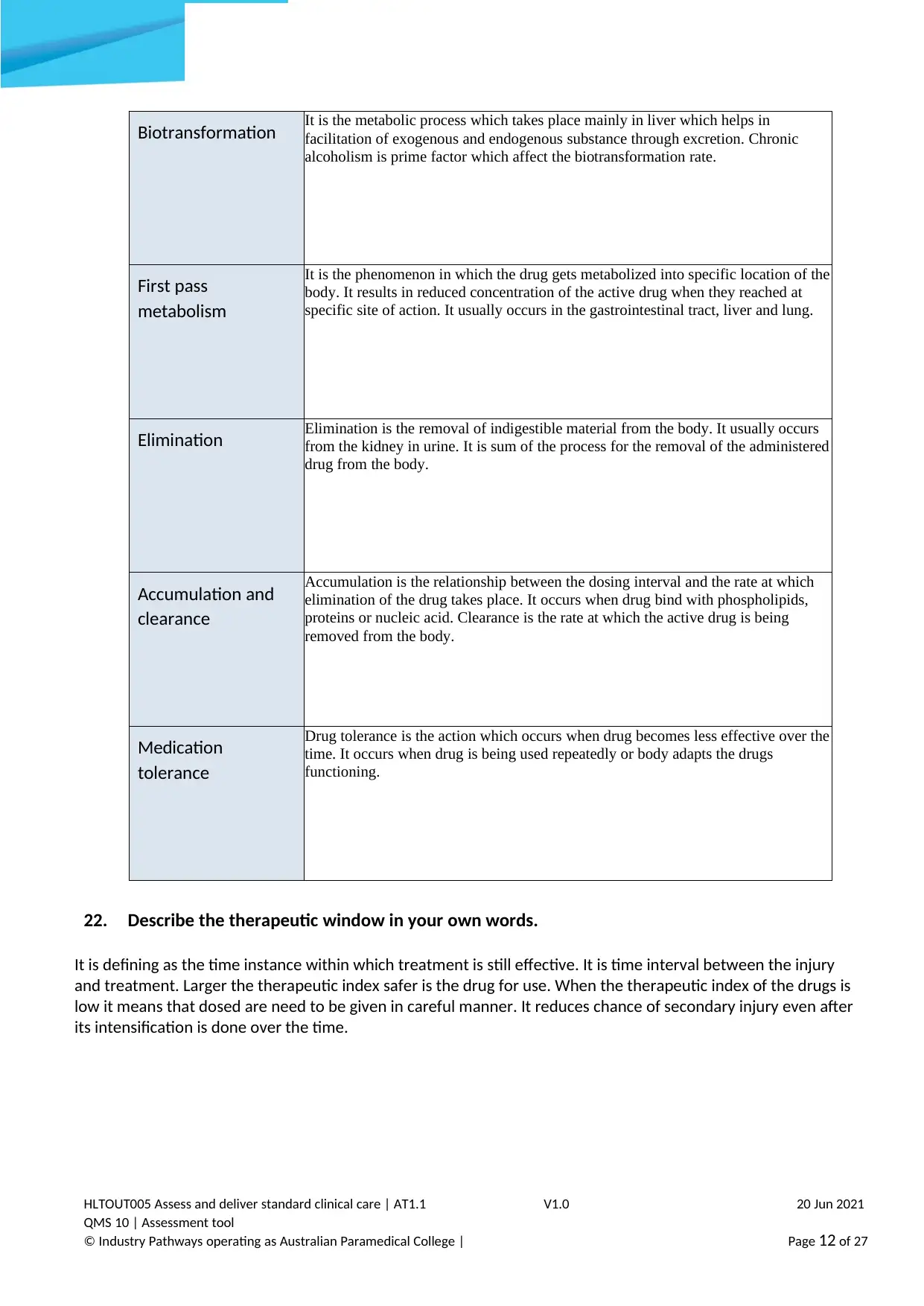
HLTOUT005 Assess and deliver standard clinical care | AT1.1
QMS 10 | Assessment tool
© Industry Pathways operating as Australian Paramedical College |
RTO32513
V1.0 20 Jun 2021
Page 12 of 27
Biotransformation It is the metabolic process which takes place mainly in liver which helps in
facilitation of exogenous and endogenous substance through excretion. Chronic
alcoholism is prime factor which affect the biotransformation rate.
First pass
metabolism
It is the phenomenon in which the drug gets metabolized into specific location of the
body. It results in reduced concentration of the active drug when they reached at
specific site of action. It usually occurs in the gastrointestinal tract, liver and lung.
Elimination Elimination is the removal of indigestible material from the body. It usually occurs
from the kidney in urine. It is sum of the process for the removal of the administered
drug from the body.
Accumulation and
clearance
Accumulation is the relationship between the dosing interval and the rate at which
elimination of the drug takes place. It occurs when drug bind with phospholipids,
proteins or nucleic acid. Clearance is the rate at which the active drug is being
removed from the body.
Medication
tolerance
Drug tolerance is the action which occurs when drug becomes less effective over the
time. It occurs when drug is being used repeatedly or body adapts the drugs
functioning.
22. Describe the therapeutic window in your own words.
It is defining as the time instance within which treatment is still effective. It is time interval between the injury
and treatment. Larger the therapeutic index safer is the drug for use. When the therapeutic index of the drugs is
low it means that dosed are need to be given in careful manner. It reduces chance of secondary injury even after
its intensification is done over the time.
QMS 10 | Assessment tool
© Industry Pathways operating as Australian Paramedical College |
RTO32513
V1.0 20 Jun 2021
Page 12 of 27
Biotransformation It is the metabolic process which takes place mainly in liver which helps in
facilitation of exogenous and endogenous substance through excretion. Chronic
alcoholism is prime factor which affect the biotransformation rate.
First pass
metabolism
It is the phenomenon in which the drug gets metabolized into specific location of the
body. It results in reduced concentration of the active drug when they reached at
specific site of action. It usually occurs in the gastrointestinal tract, liver and lung.
Elimination Elimination is the removal of indigestible material from the body. It usually occurs
from the kidney in urine. It is sum of the process for the removal of the administered
drug from the body.
Accumulation and
clearance
Accumulation is the relationship between the dosing interval and the rate at which
elimination of the drug takes place. It occurs when drug bind with phospholipids,
proteins or nucleic acid. Clearance is the rate at which the active drug is being
removed from the body.
Medication
tolerance
Drug tolerance is the action which occurs when drug becomes less effective over the
time. It occurs when drug is being used repeatedly or body adapts the drugs
functioning.
22. Describe the therapeutic window in your own words.
It is defining as the time instance within which treatment is still effective. It is time interval between the injury
and treatment. Larger the therapeutic index safer is the drug for use. When the therapeutic index of the drugs is
low it means that dosed are need to be given in careful manner. It reduces chance of secondary injury even after
its intensification is done over the time.
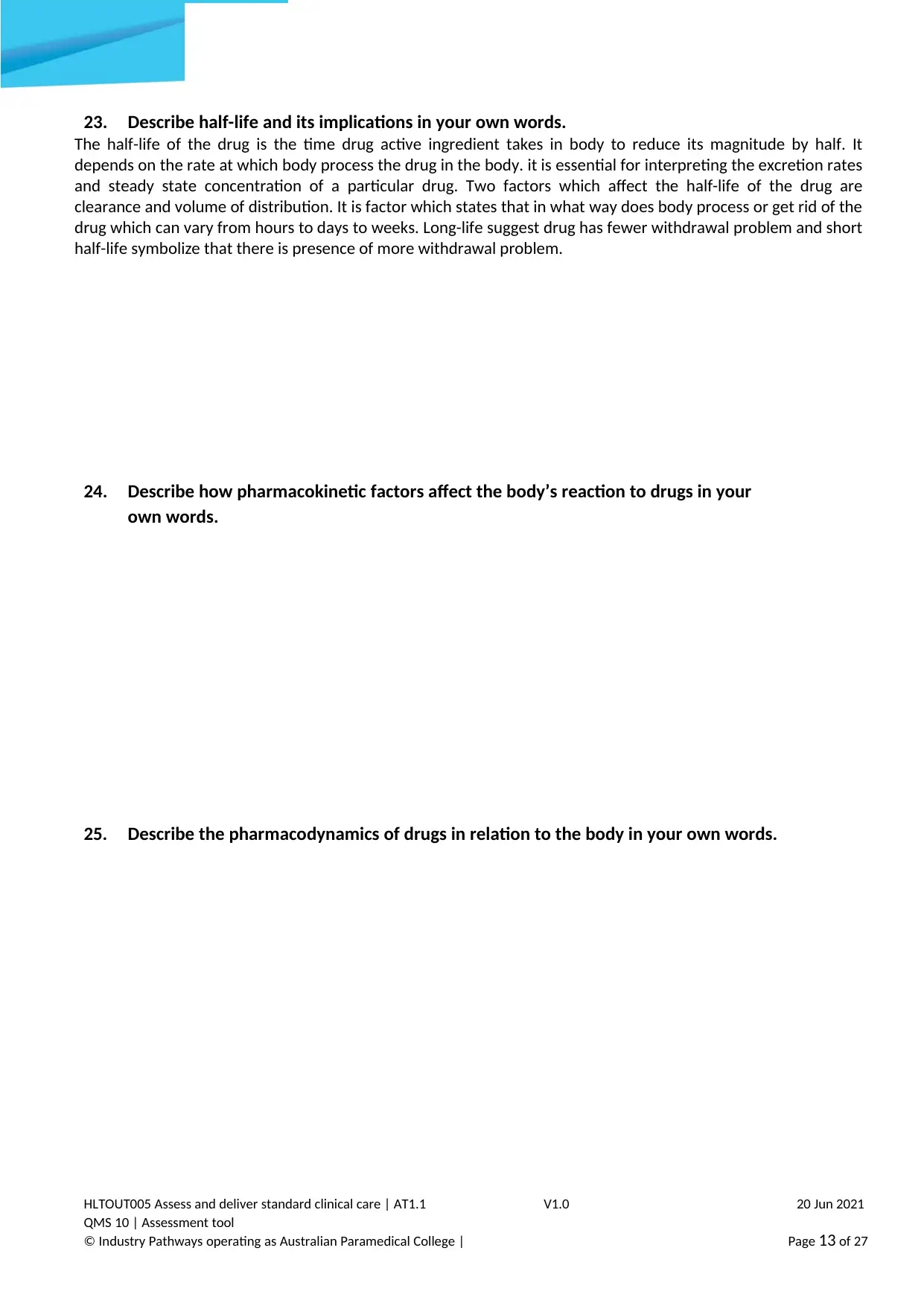
HLTOUT005 Assess and deliver standard clinical care | AT1.1
QMS 10 | Assessment tool
© Industry Pathways operating as Australian Paramedical College |
RTO32513
V1.0 20 Jun 2021
Page 13 of 27
23. Describe half-life and its implications in your own words.
The half-life of the drug is the time drug active ingredient takes in body to reduce its magnitude by half. It
depends on the rate at which body process the drug in the body. it is essential for interpreting the excretion rates
and steady state concentration of a particular drug. Two factors which affect the half-life of the drug are
clearance and volume of distribution. It is factor which states that in what way does body process or get rid of the
drug which can vary from hours to days to weeks. Long-life suggest drug has fewer withdrawal problem and short
half-life symbolize that there is presence of more withdrawal problem.
24. Describe how pharmacokinetic factors affect the body’s reaction to drugs in your
own words.
25. Describe the pharmacodynamics of drugs in relation to the body in your own words.
QMS 10 | Assessment tool
© Industry Pathways operating as Australian Paramedical College |
RTO32513
V1.0 20 Jun 2021
Page 13 of 27
23. Describe half-life and its implications in your own words.
The half-life of the drug is the time drug active ingredient takes in body to reduce its magnitude by half. It
depends on the rate at which body process the drug in the body. it is essential for interpreting the excretion rates
and steady state concentration of a particular drug. Two factors which affect the half-life of the drug are
clearance and volume of distribution. It is factor which states that in what way does body process or get rid of the
drug which can vary from hours to days to weeks. Long-life suggest drug has fewer withdrawal problem and short
half-life symbolize that there is presence of more withdrawal problem.
24. Describe how pharmacokinetic factors affect the body’s reaction to drugs in your
own words.
25. Describe the pharmacodynamics of drugs in relation to the body in your own words.
Paraphrase This Document
Need a fresh take? Get an instant paraphrase of this document with our AI Paraphraser

HLTOUT005 Assess and deliver standard clinical care | AT1.1
QMS 10 | Assessment tool
© Industry Pathways operating as Australian Paramedical College |
RTO32513
V1.0 20 Jun 2021
Page 14 of 27
26. Describe drug receptors in your own words.
27. Explain the difference between an opiate and an opioid in your own words.
28. List three (3) side effects of an opioid.
QMS 10 | Assessment tool
© Industry Pathways operating as Australian Paramedical College |
RTO32513
V1.0 20 Jun 2021
Page 14 of 27
26. Describe drug receptors in your own words.
27. Explain the difference between an opiate and an opioid in your own words.
28. List three (3) side effects of an opioid.
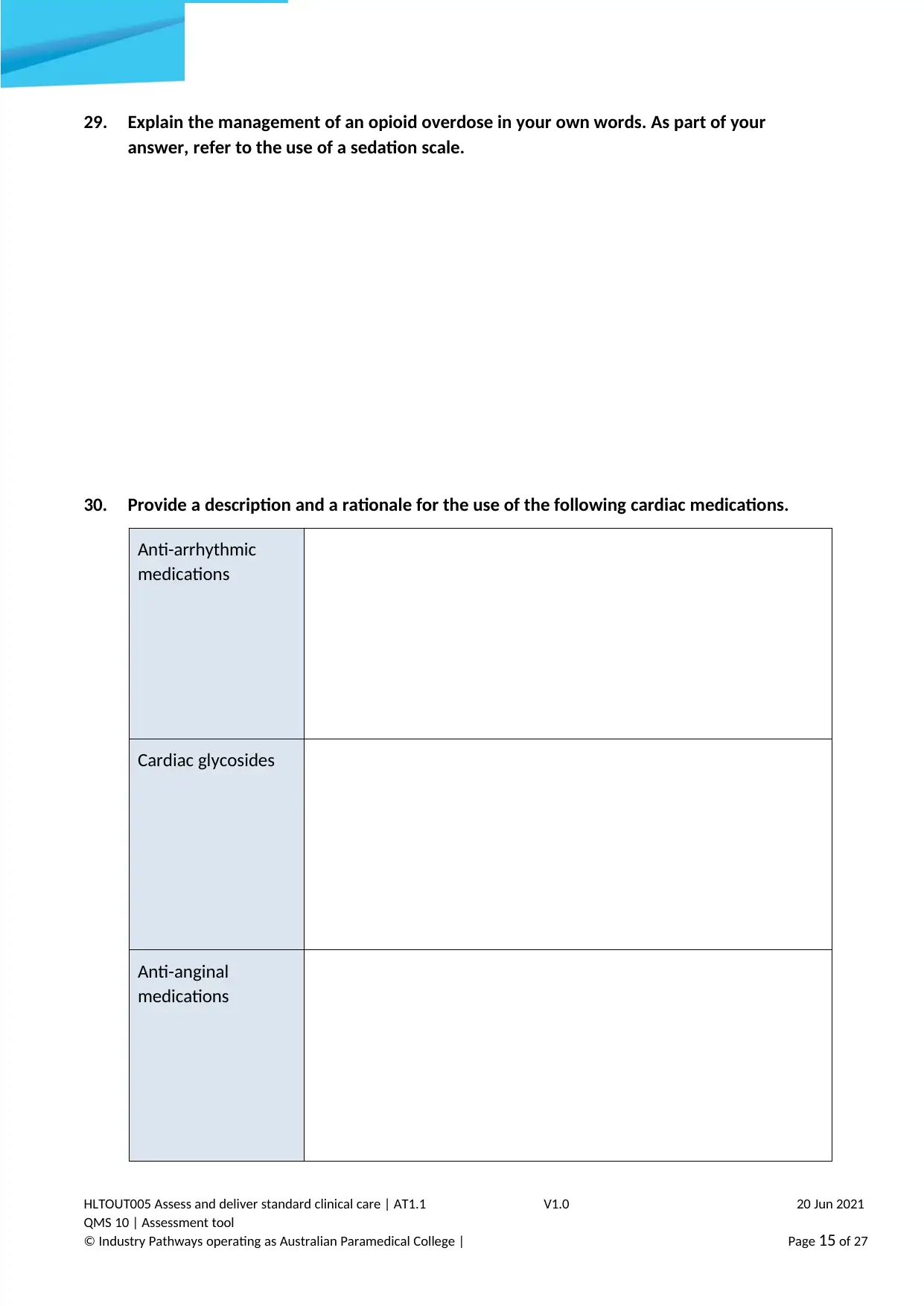
HLTOUT005 Assess and deliver standard clinical care | AT1.1
QMS 10 | Assessment tool
© Industry Pathways operating as Australian Paramedical College |
RTO32513
V1.0 20 Jun 2021
Page 15 of 27
29. Explain the management of an opioid overdose in your own words. As part of your
answer, refer to the use of a sedation scale.
30. Provide a description and a rationale for the use of the following cardiac medications.
Anti-arrhythmic
medications
Cardiac glycosides
Anti-anginal
medications
QMS 10 | Assessment tool
© Industry Pathways operating as Australian Paramedical College |
RTO32513
V1.0 20 Jun 2021
Page 15 of 27
29. Explain the management of an opioid overdose in your own words. As part of your
answer, refer to the use of a sedation scale.
30. Provide a description and a rationale for the use of the following cardiac medications.
Anti-arrhythmic
medications
Cardiac glycosides
Anti-anginal
medications
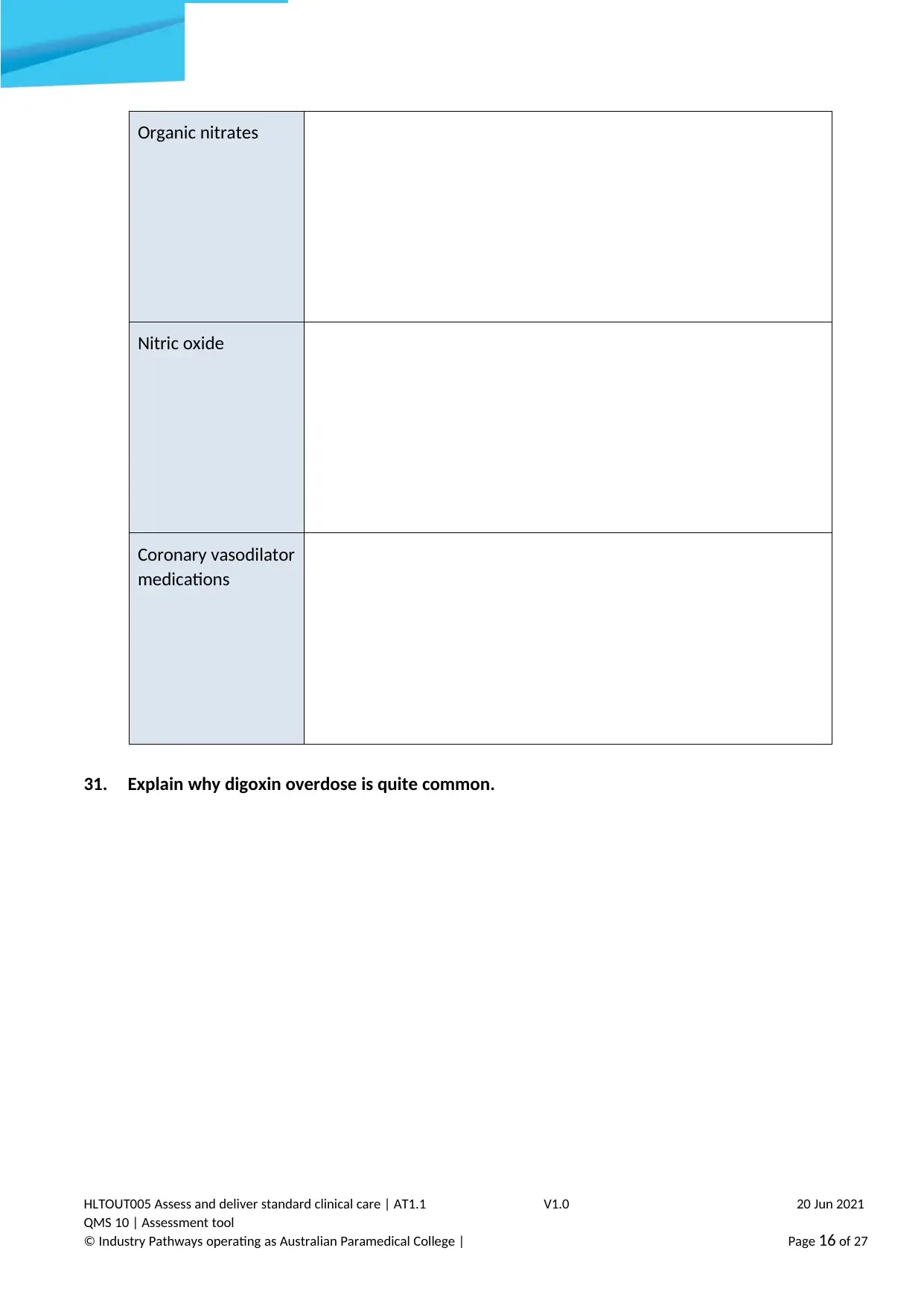
HLTOUT005 Assess and deliver standard clinical care | AT1.1
QMS 10 | Assessment tool
© Industry Pathways operating as Australian Paramedical College |
RTO32513
V1.0 20 Jun 2021
Page 16 of 27
Organic nitrates
Nitric oxide
Coronary vasodilator
medications
31. Explain why digoxin overdose is quite common.
QMS 10 | Assessment tool
© Industry Pathways operating as Australian Paramedical College |
RTO32513
V1.0 20 Jun 2021
Page 16 of 27
Organic nitrates
Nitric oxide
Coronary vasodilator
medications
31. Explain why digoxin overdose is quite common.
Secure Best Marks with AI Grader
Need help grading? Try our AI Grader for instant feedback on your assignments.
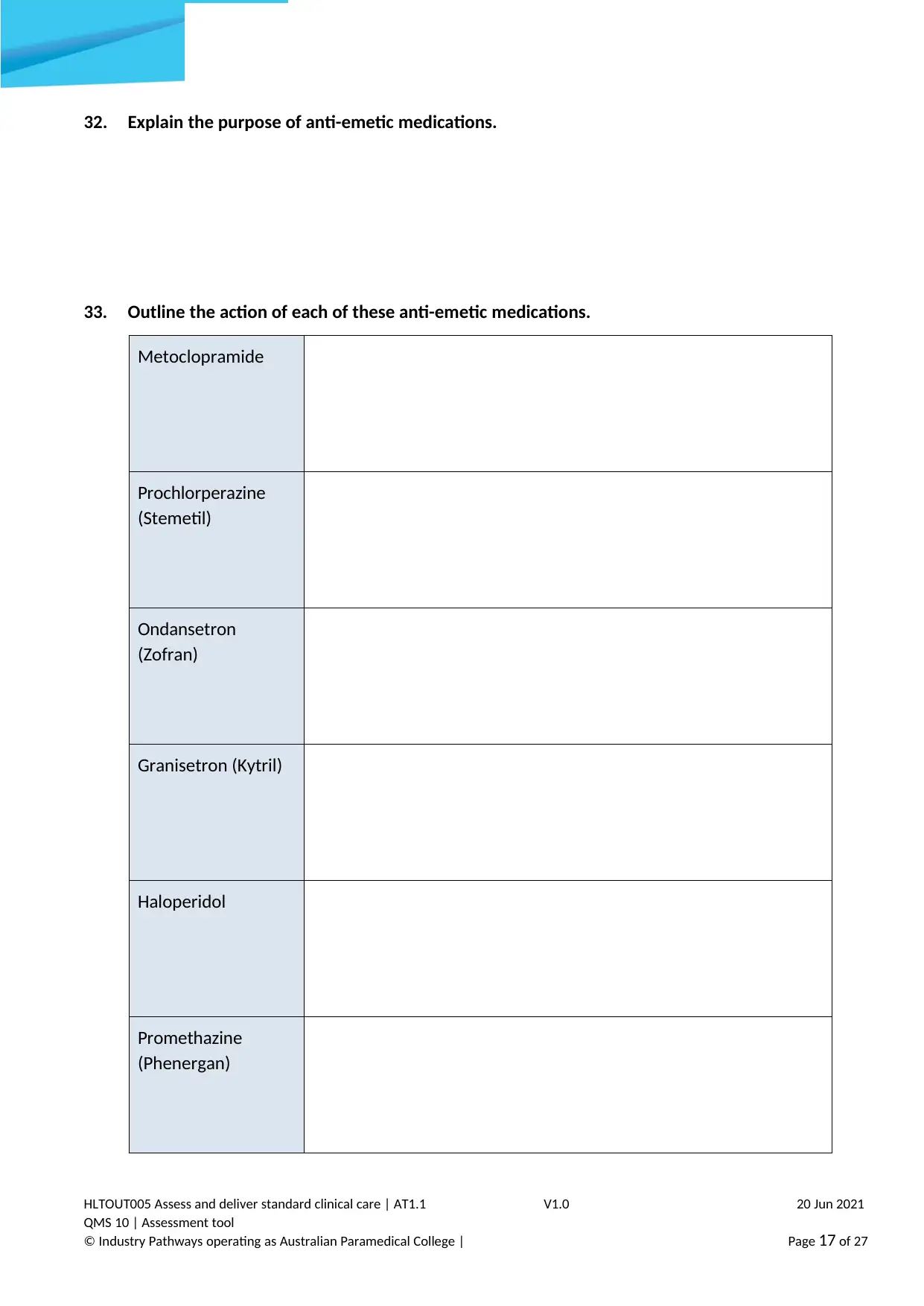
HLTOUT005 Assess and deliver standard clinical care | AT1.1
QMS 10 | Assessment tool
© Industry Pathways operating as Australian Paramedical College |
RTO32513
V1.0 20 Jun 2021
Page 17 of 27
32. Explain the purpose of anti-emetic medications.
33. Outline the action of each of these anti-emetic medications.
Metoclopramide
Prochlorperazine
(Stemetil)
Ondansetron
(Zofran)
Granisetron (Kytril)
Haloperidol
Promethazine
(Phenergan)
QMS 10 | Assessment tool
© Industry Pathways operating as Australian Paramedical College |
RTO32513
V1.0 20 Jun 2021
Page 17 of 27
32. Explain the purpose of anti-emetic medications.
33. Outline the action of each of these anti-emetic medications.
Metoclopramide
Prochlorperazine
(Stemetil)
Ondansetron
(Zofran)
Granisetron (Kytril)
Haloperidol
Promethazine
(Phenergan)
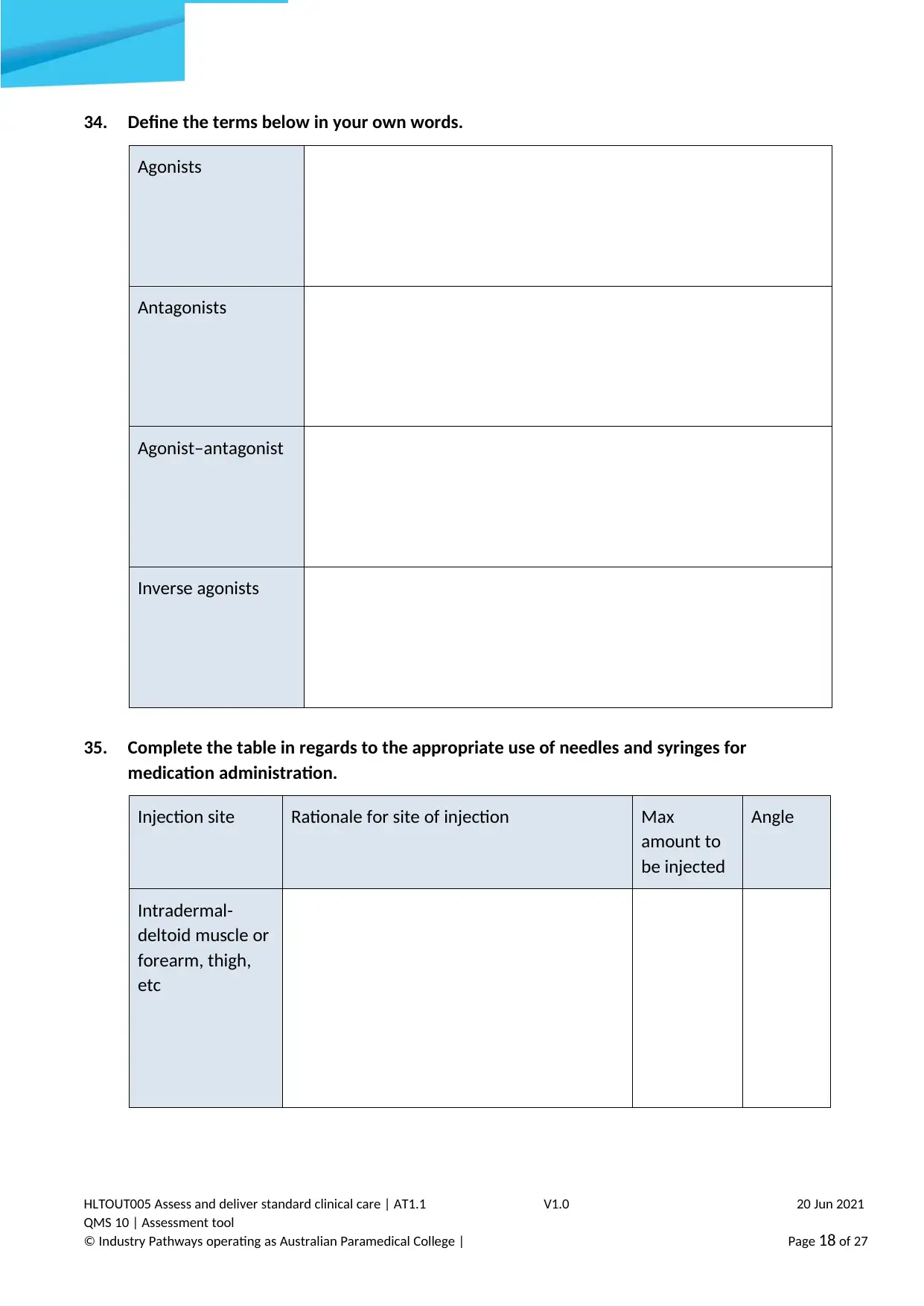
HLTOUT005 Assess and deliver standard clinical care | AT1.1
QMS 10 | Assessment tool
© Industry Pathways operating as Australian Paramedical College |
RTO32513
V1.0 20 Jun 2021
Page 18 of 27
34. Define the terms below in your own words.
Agonists
Antagonists
Agonist–antagonist
Inverse agonists
35. Complete the table in regards to the appropriate use of needles and syringes for
medication administration.
Injection site Rationale for site of injection Max
amount to
be injected
Angle
Intradermal-
deltoid muscle or
forearm, thigh,
etc
QMS 10 | Assessment tool
© Industry Pathways operating as Australian Paramedical College |
RTO32513
V1.0 20 Jun 2021
Page 18 of 27
34. Define the terms below in your own words.
Agonists
Antagonists
Agonist–antagonist
Inverse agonists
35. Complete the table in regards to the appropriate use of needles and syringes for
medication administration.
Injection site Rationale for site of injection Max
amount to
be injected
Angle
Intradermal-
deltoid muscle or
forearm, thigh,
etc
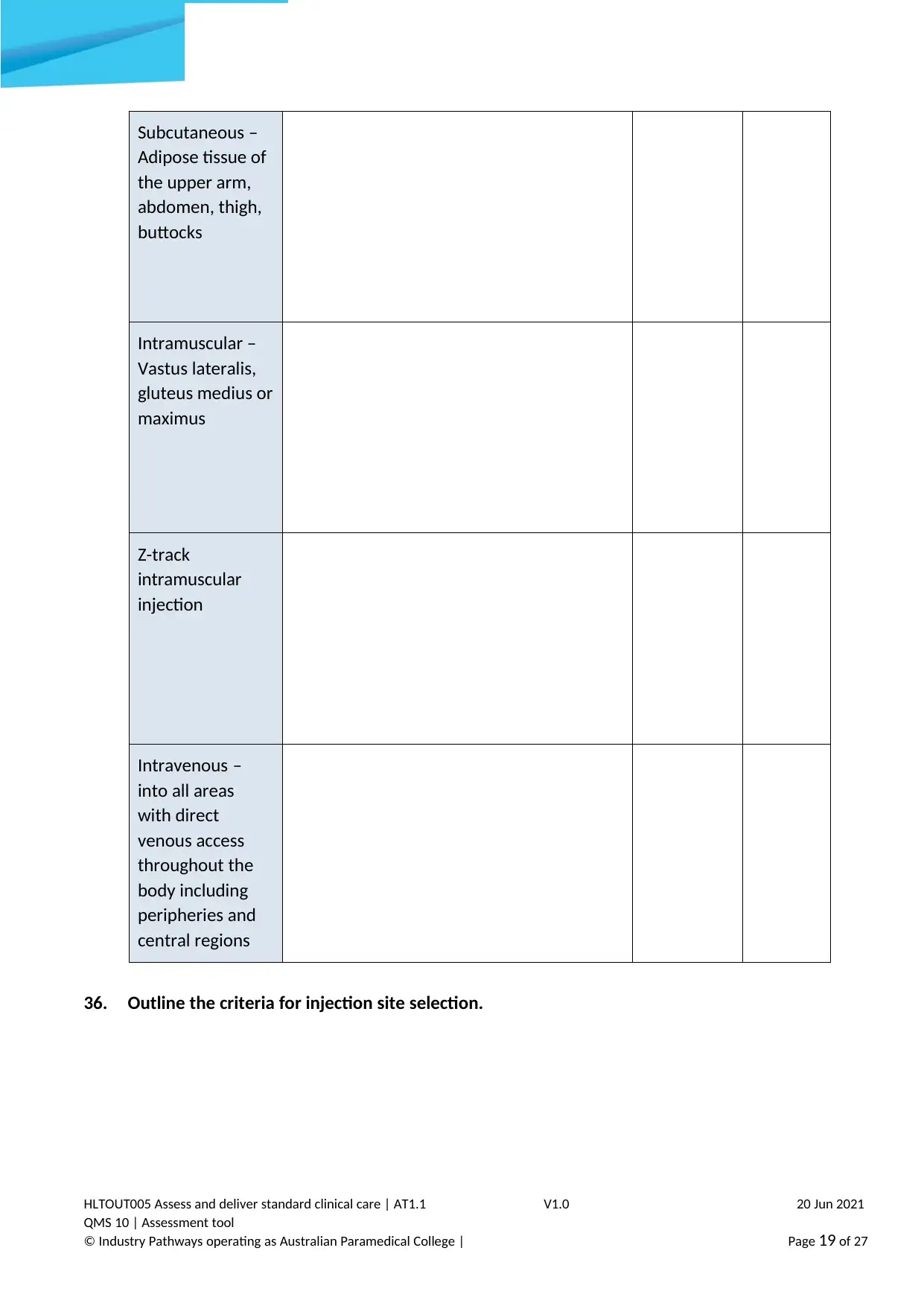
HLTOUT005 Assess and deliver standard clinical care | AT1.1
QMS 10 | Assessment tool
© Industry Pathways operating as Australian Paramedical College |
RTO32513
V1.0 20 Jun 2021
Page 19 of 27
Subcutaneous –
Adipose tissue of
the upper arm,
abdomen, thigh,
buttocks
Intramuscular –
Vastus lateralis,
gluteus medius or
maximus
Z-track
intramuscular
injection
Intravenous –
into all areas
with direct
venous access
throughout the
body including
peripheries and
central regions
36. Outline the criteria for injection site selection.
QMS 10 | Assessment tool
© Industry Pathways operating as Australian Paramedical College |
RTO32513
V1.0 20 Jun 2021
Page 19 of 27
Subcutaneous –
Adipose tissue of
the upper arm,
abdomen, thigh,
buttocks
Intramuscular –
Vastus lateralis,
gluteus medius or
maximus
Z-track
intramuscular
injection
Intravenous –
into all areas
with direct
venous access
throughout the
body including
peripheries and
central regions
36. Outline the criteria for injection site selection.
Paraphrase This Document
Need a fresh take? Get an instant paraphrase of this document with our AI Paraphraser
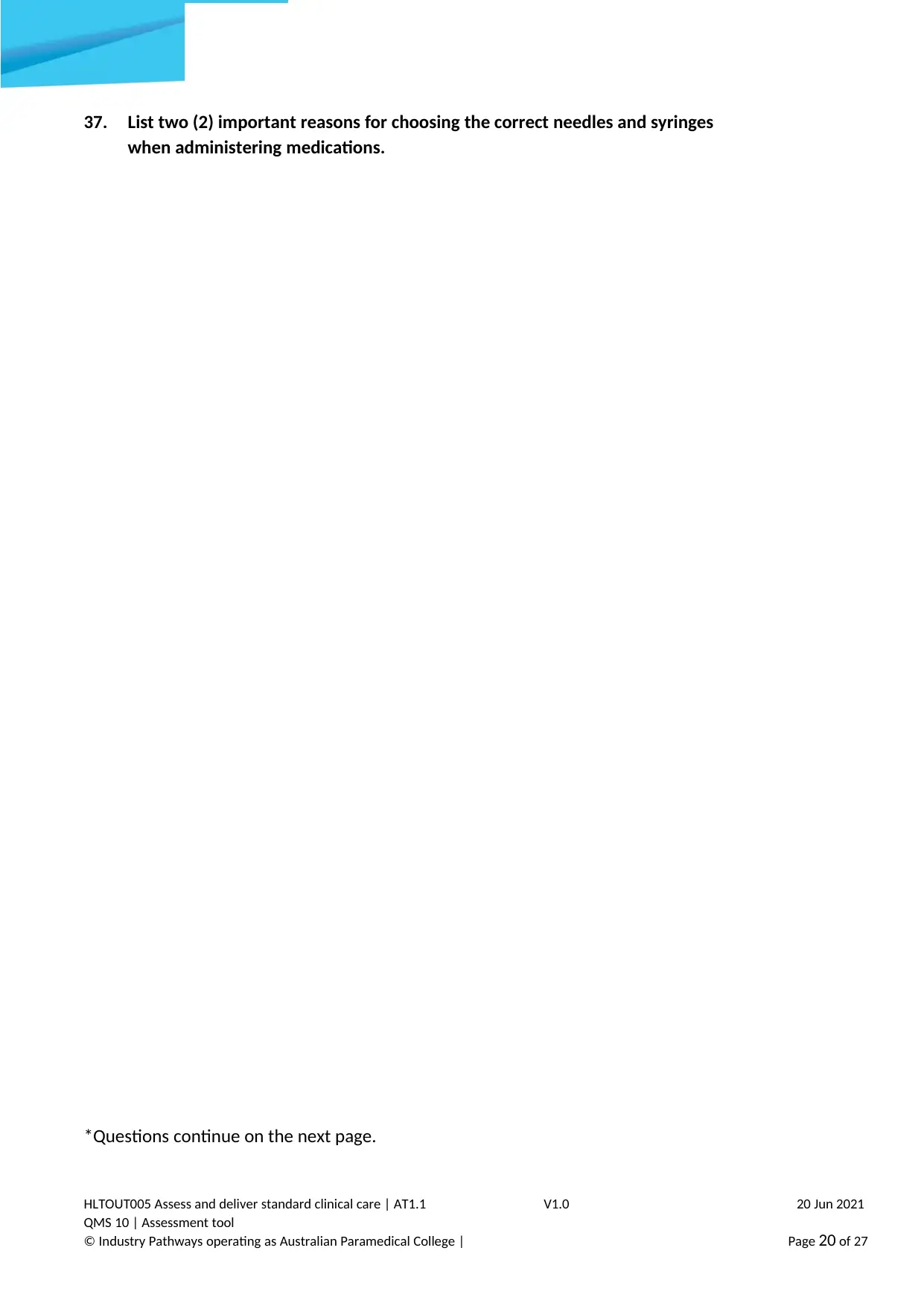
HLTOUT005 Assess and deliver standard clinical care | AT1.1
QMS 10 | Assessment tool
© Industry Pathways operating as Australian Paramedical College |
RTO32513
V1.0 20 Jun 2021
Page 20 of 27
37. List two (2) important reasons for choosing the correct needles and syringes
when administering medications.
*Questions continue on the next page.
QMS 10 | Assessment tool
© Industry Pathways operating as Australian Paramedical College |
RTO32513
V1.0 20 Jun 2021
Page 20 of 27
37. List two (2) important reasons for choosing the correct needles and syringes
when administering medications.
*Questions continue on the next page.
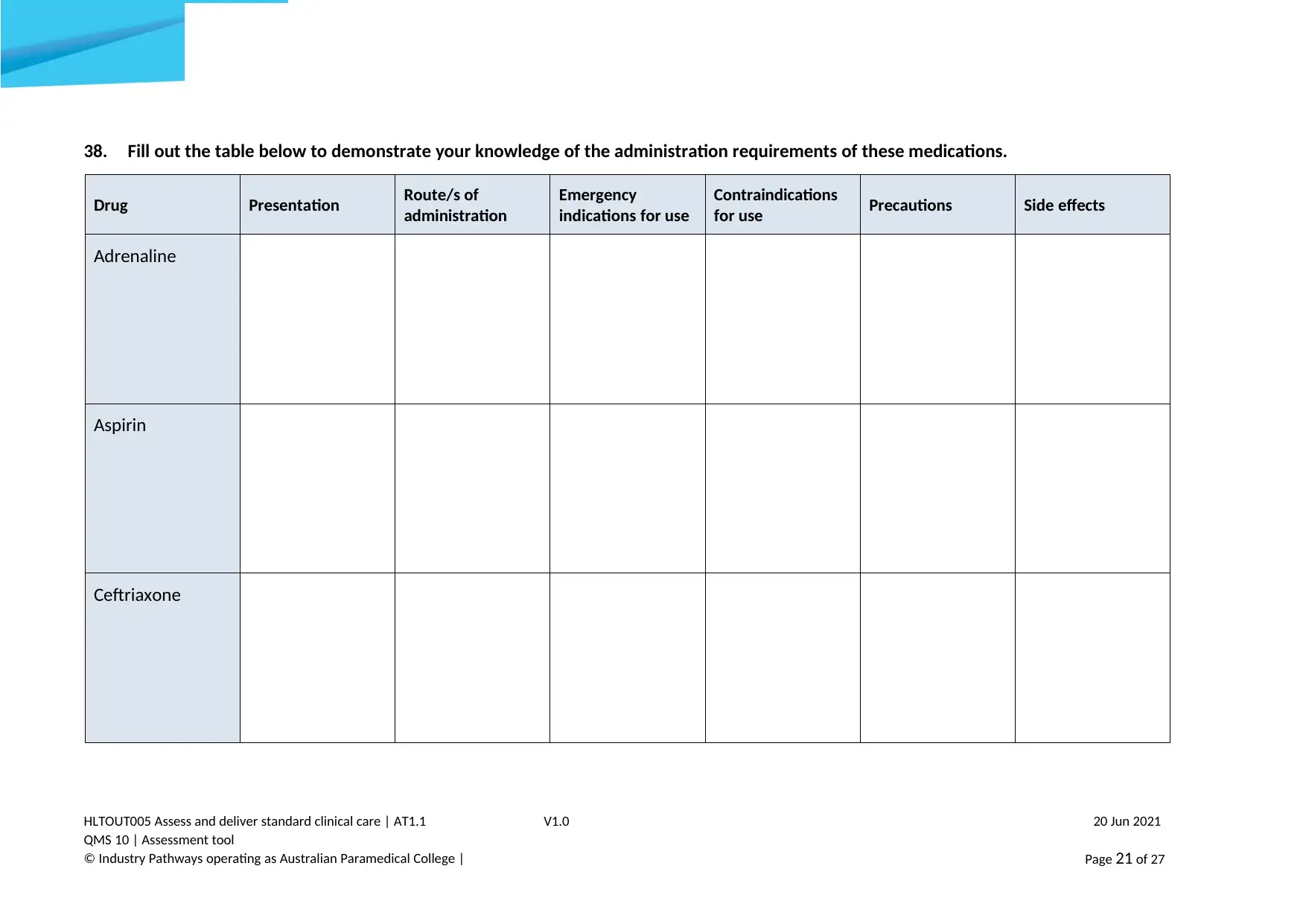
HLTOUT005 Assess and deliver standard clinical care | AT1.1
QMS 10 | Assessment tool
© Industry Pathways operating as Australian Paramedical College |
RTO32513
V1.0 20 Jun 2021
Page 21 of 27
38. Fill out the table below to demonstrate your knowledge of the administration requirements of these medications.
Drug Presentation Route/s of
administration
Emergency
indications for use
Contraindications
for use Precautions Side effects
Adrenaline
Aspirin
Ceftriaxone
QMS 10 | Assessment tool
© Industry Pathways operating as Australian Paramedical College |
RTO32513
V1.0 20 Jun 2021
Page 21 of 27
38. Fill out the table below to demonstrate your knowledge of the administration requirements of these medications.
Drug Presentation Route/s of
administration
Emergency
indications for use
Contraindications
for use Precautions Side effects
Adrenaline
Aspirin
Ceftriaxone
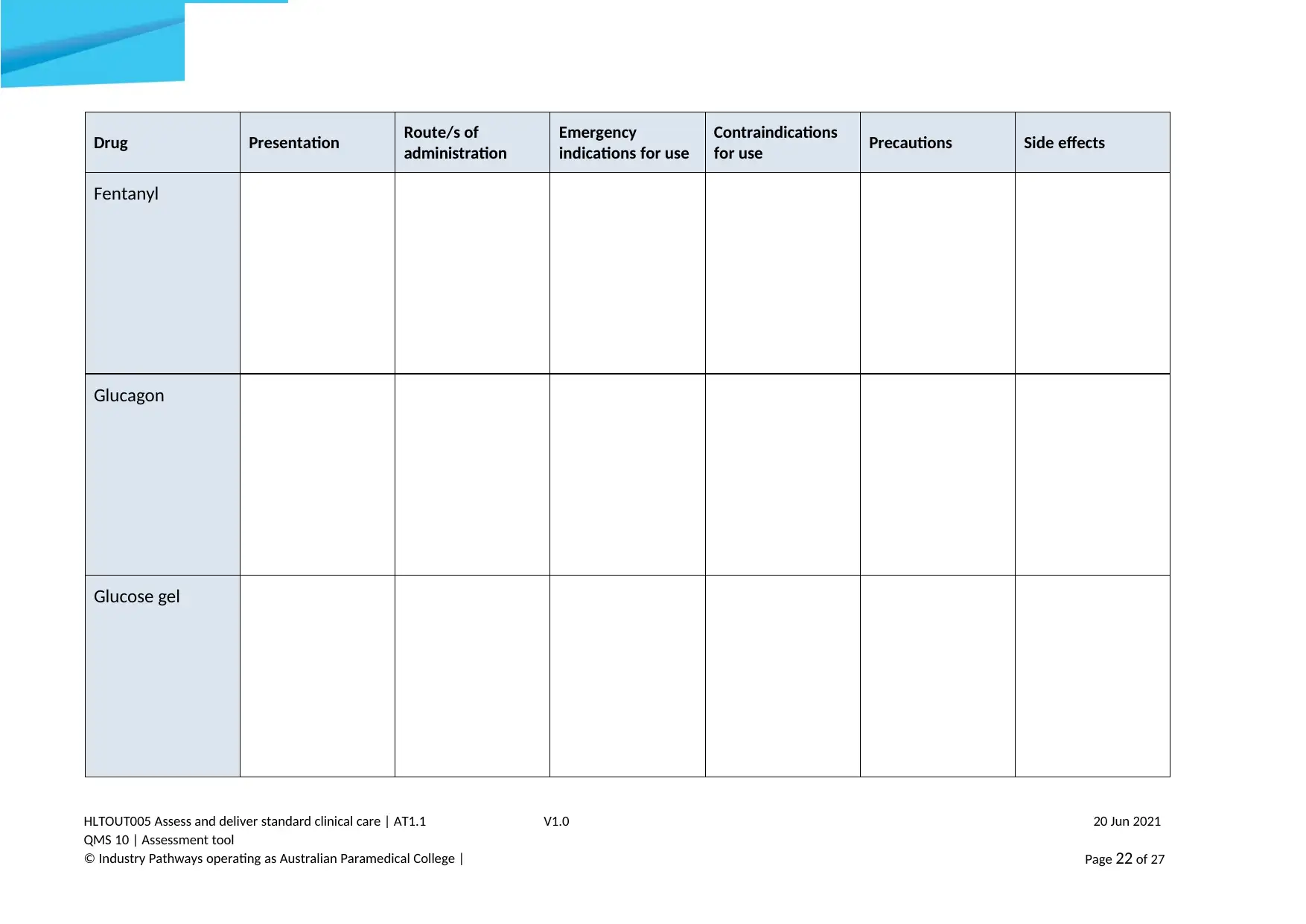
HLTOUT005 Assess and deliver standard clinical care | AT1.1
QMS 10 | Assessment tool
© Industry Pathways operating as Australian Paramedical College |
RTO32513
V1.0 20 Jun 2021
Page 22 of 27
Drug Presentation Route/s of
administration
Emergency
indications for use
Contraindications
for use Precautions Side effects
Fentanyl
Glucagon
Glucose gel
QMS 10 | Assessment tool
© Industry Pathways operating as Australian Paramedical College |
RTO32513
V1.0 20 Jun 2021
Page 22 of 27
Drug Presentation Route/s of
administration
Emergency
indications for use
Contraindications
for use Precautions Side effects
Fentanyl
Glucagon
Glucose gel
Secure Best Marks with AI Grader
Need help grading? Try our AI Grader for instant feedback on your assignments.
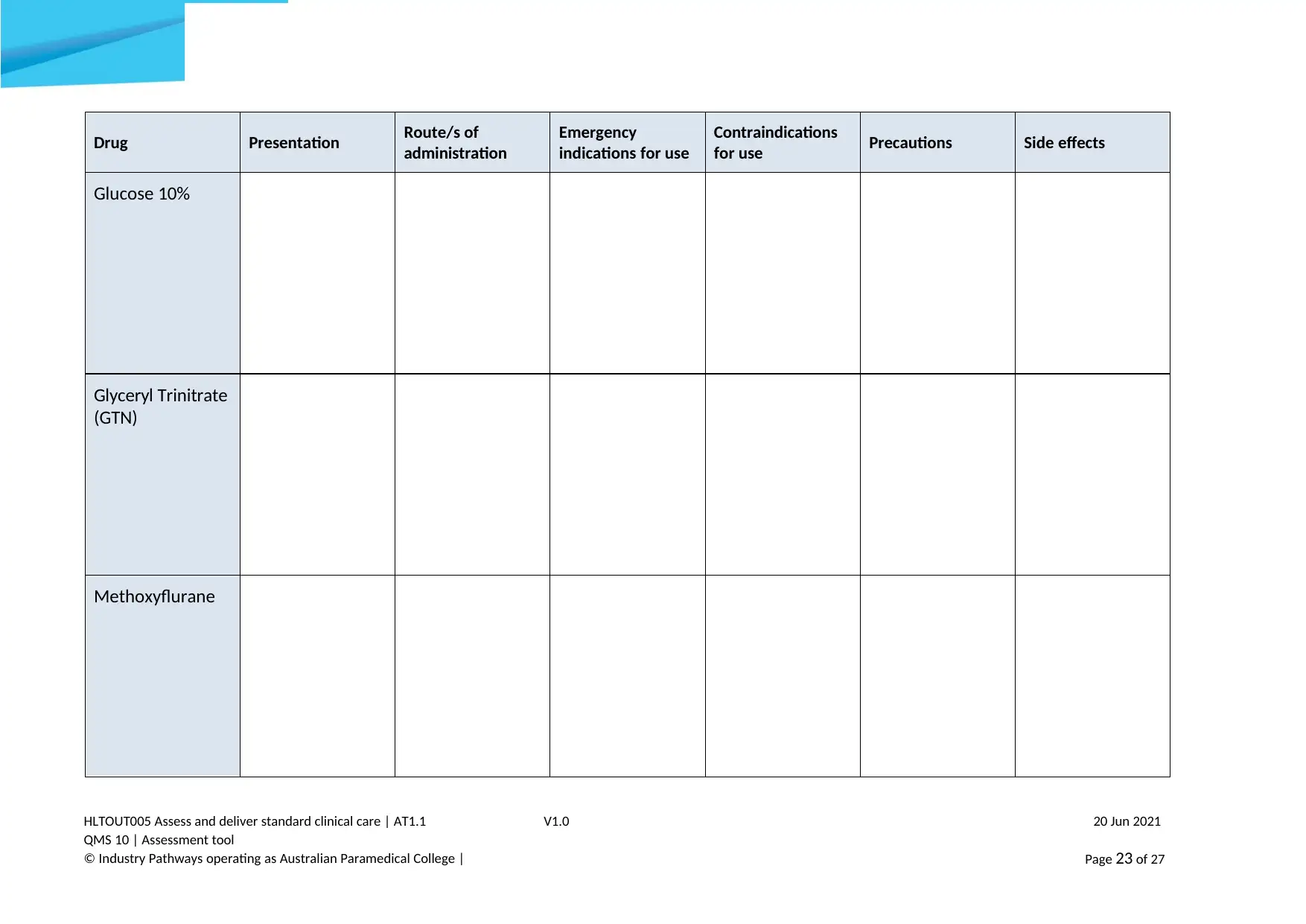
HLTOUT005 Assess and deliver standard clinical care | AT1.1
QMS 10 | Assessment tool
© Industry Pathways operating as Australian Paramedical College |
RTO32513
V1.0 20 Jun 2021
Page 23 of 27
Drug Presentation Route/s of
administration
Emergency
indications for use
Contraindications
for use Precautions Side effects
Glucose 10%
Glyceryl Trinitrate
(GTN)
Methoxyflurane
QMS 10 | Assessment tool
© Industry Pathways operating as Australian Paramedical College |
RTO32513
V1.0 20 Jun 2021
Page 23 of 27
Drug Presentation Route/s of
administration
Emergency
indications for use
Contraindications
for use Precautions Side effects
Glucose 10%
Glyceryl Trinitrate
(GTN)
Methoxyflurane
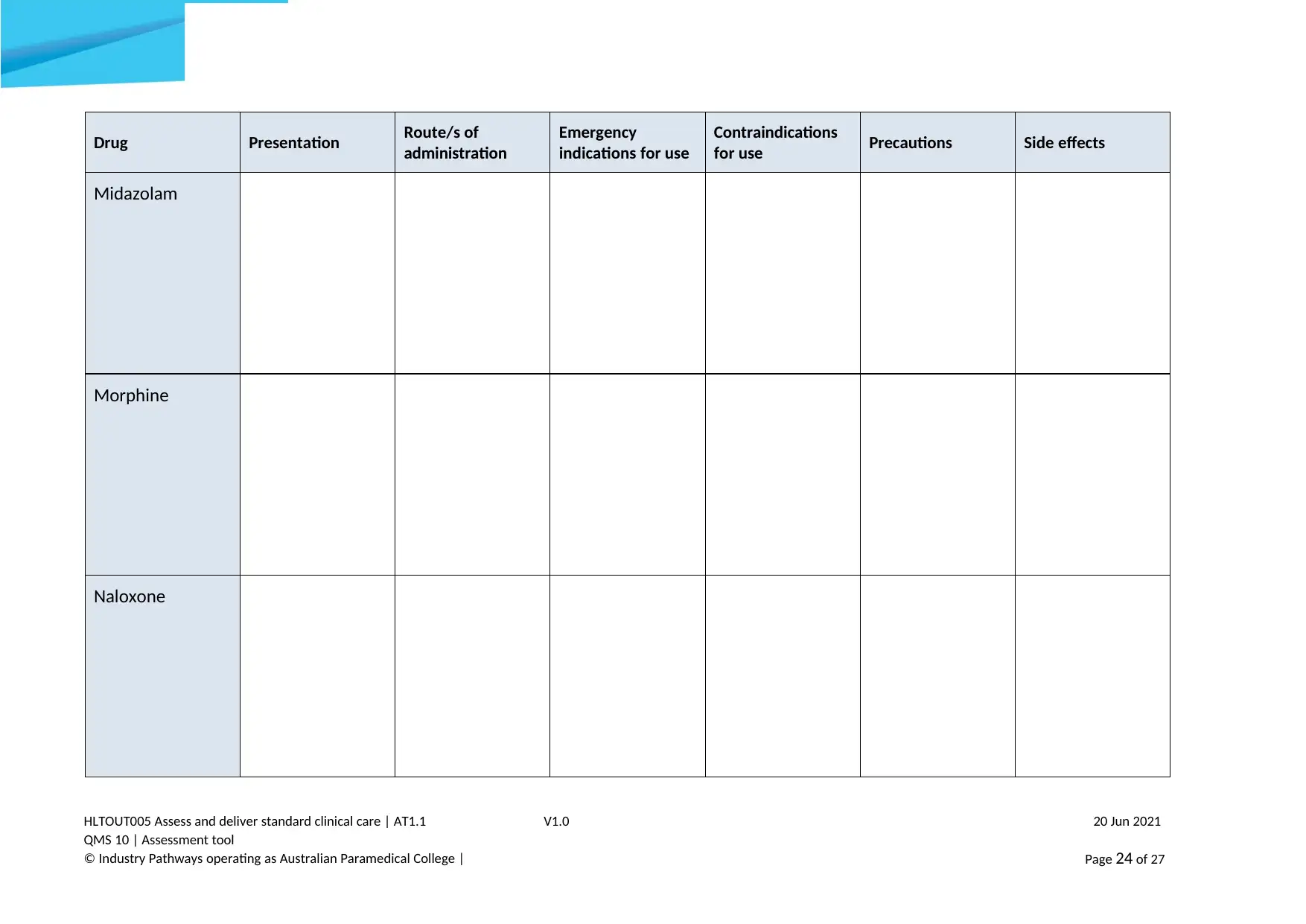
HLTOUT005 Assess and deliver standard clinical care | AT1.1
QMS 10 | Assessment tool
© Industry Pathways operating as Australian Paramedical College |
RTO32513
V1.0 20 Jun 2021
Page 24 of 27
Drug Presentation Route/s of
administration
Emergency
indications for use
Contraindications
for use Precautions Side effects
Midazolam
Morphine
Naloxone
QMS 10 | Assessment tool
© Industry Pathways operating as Australian Paramedical College |
RTO32513
V1.0 20 Jun 2021
Page 24 of 27
Drug Presentation Route/s of
administration
Emergency
indications for use
Contraindications
for use Precautions Side effects
Midazolam
Morphine
Naloxone
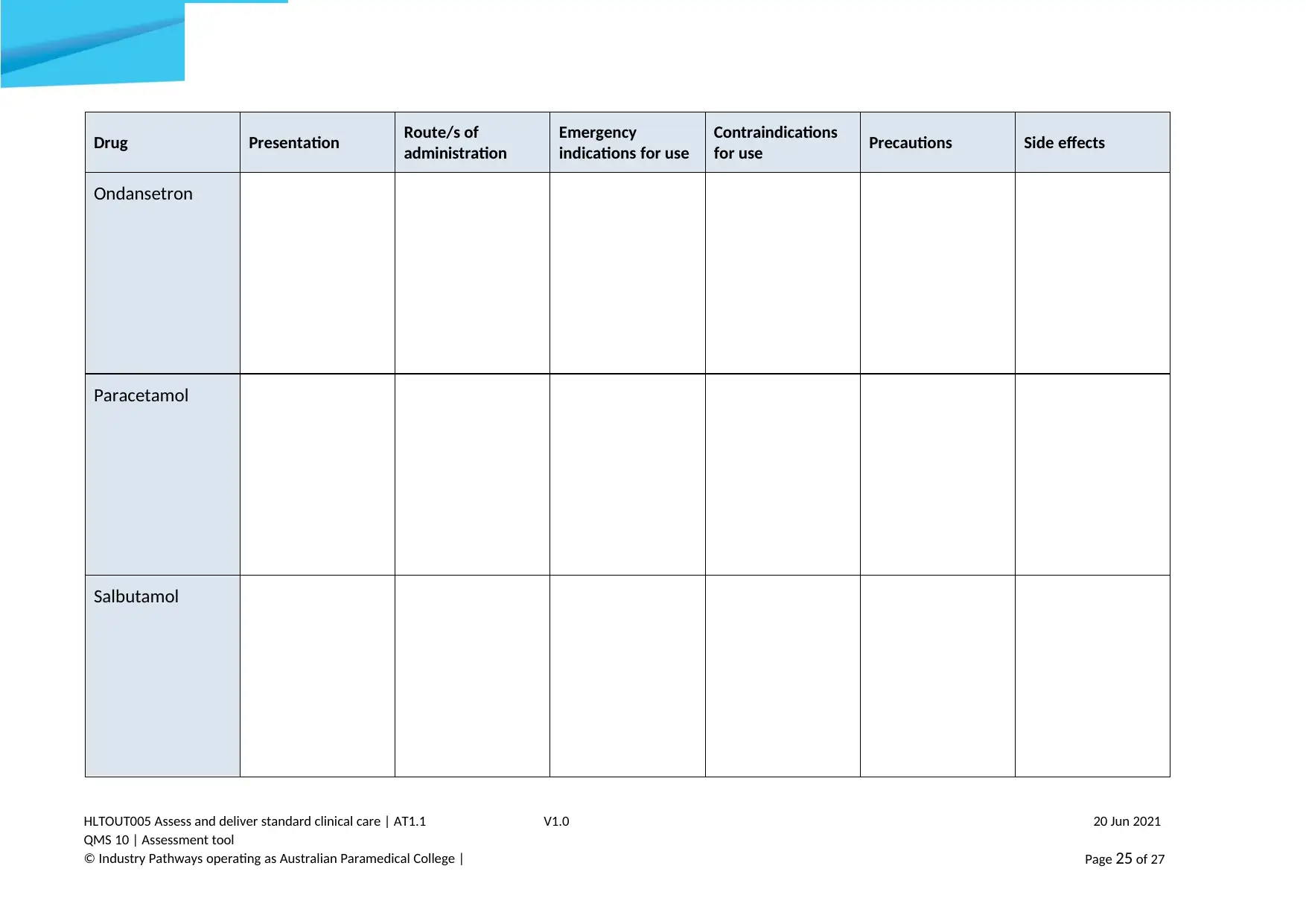
HLTOUT005 Assess and deliver standard clinical care | AT1.1
QMS 10 | Assessment tool
© Industry Pathways operating as Australian Paramedical College |
RTO32513
V1.0 20 Jun 2021
Page 25 of 27
Drug Presentation Route/s of
administration
Emergency
indications for use
Contraindications
for use Precautions Side effects
Ondansetron
Paracetamol
Salbutamol
QMS 10 | Assessment tool
© Industry Pathways operating as Australian Paramedical College |
RTO32513
V1.0 20 Jun 2021
Page 25 of 27
Drug Presentation Route/s of
administration
Emergency
indications for use
Contraindications
for use Precautions Side effects
Ondansetron
Paracetamol
Salbutamol
Paraphrase This Document
Need a fresh take? Get an instant paraphrase of this document with our AI Paraphraser
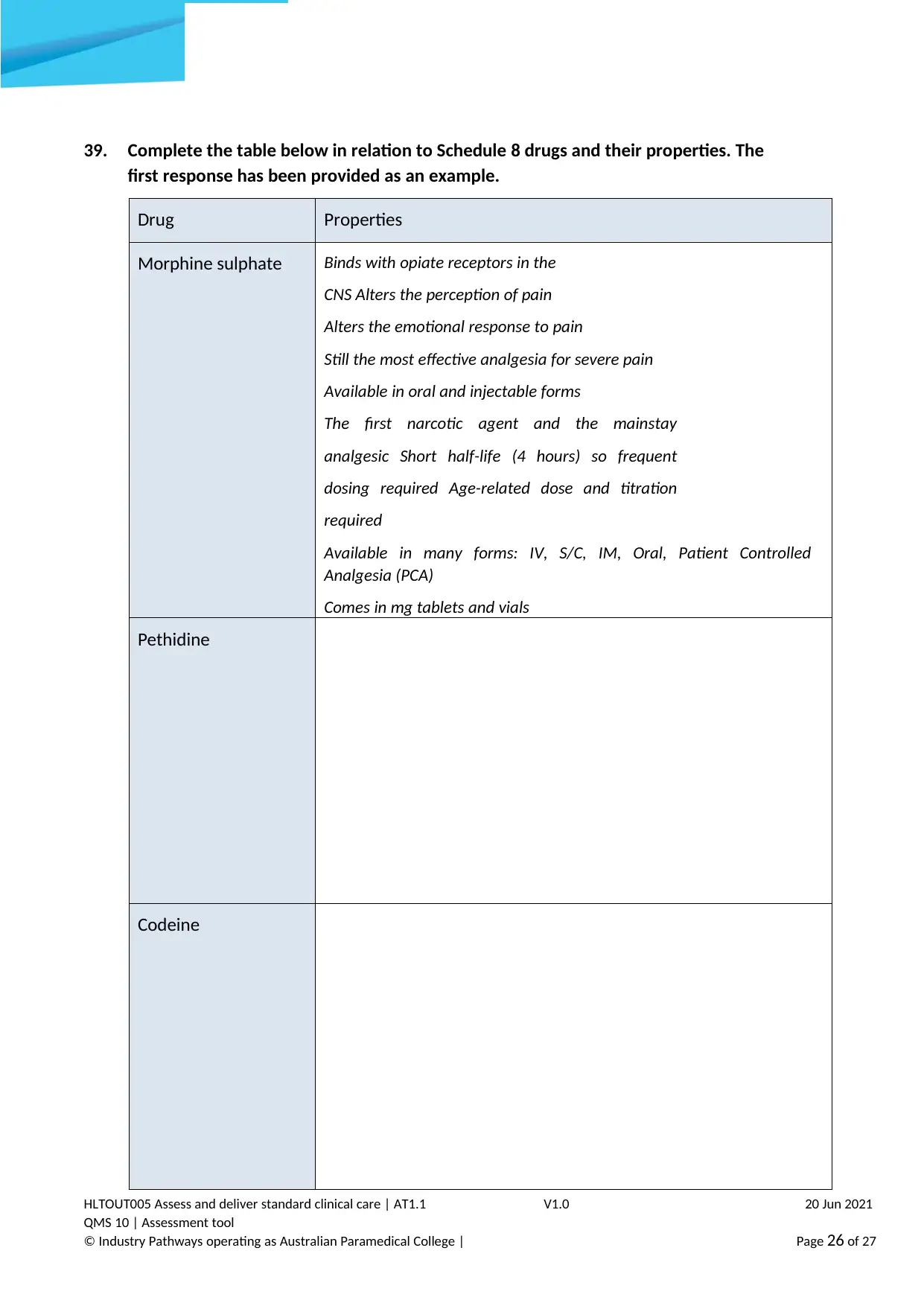
HLTOUT005 Assess and deliver standard clinical care | AT1.1
QMS 10 | Assessment tool
© Industry Pathways operating as Australian Paramedical College |
RTO32513
V1.0 20 Jun 2021
Page 26 of 27
39. Complete the table below in relation to Schedule 8 drugs and their properties. The
first response has been provided as an example.
Drug Properties
Morphine sulphate Binds with opiate receptors in the
CNS Alters the perception of pain
Alters the emotional response to pain
Still the most effective analgesia for severe pain
Available in oral and injectable forms
The first narcotic agent and the mainstay
analgesic Short half-life (4 hours) so frequent
dosing required Age-related dose and titration
required
Available in many forms: IV, S/C, IM, Oral, Patient Controlled
Analgesia (PCA)
Comes in mg tablets and vials
Pethidine
Codeine
QMS 10 | Assessment tool
© Industry Pathways operating as Australian Paramedical College |
RTO32513
V1.0 20 Jun 2021
Page 26 of 27
39. Complete the table below in relation to Schedule 8 drugs and their properties. The
first response has been provided as an example.
Drug Properties
Morphine sulphate Binds with opiate receptors in the
CNS Alters the perception of pain
Alters the emotional response to pain
Still the most effective analgesia for severe pain
Available in oral and injectable forms
The first narcotic agent and the mainstay
analgesic Short half-life (4 hours) so frequent
dosing required Age-related dose and titration
required
Available in many forms: IV, S/C, IM, Oral, Patient Controlled
Analgesia (PCA)
Comes in mg tablets and vials
Pethidine
Codeine
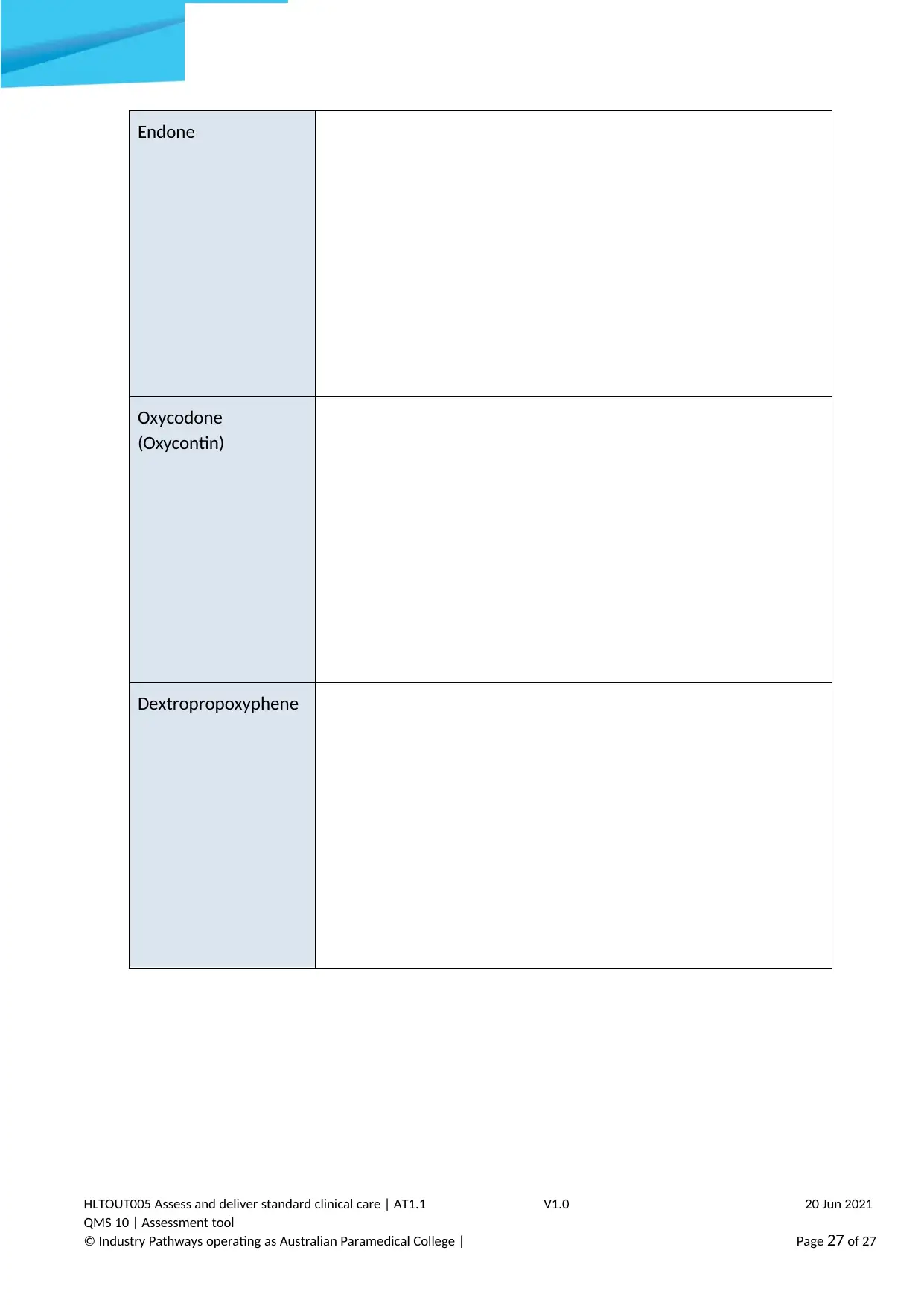
HLTOUT005 Assess and deliver standard clinical care | AT1.1
QMS 10 | Assessment tool
© Industry Pathways operating as Australian Paramedical College |
RTO32513
V1.0 20 Jun 2021
Page 27 of 27
Endone
Oxycodone
(Oxycontin)
Dextropropoxyphene
QMS 10 | Assessment tool
© Industry Pathways operating as Australian Paramedical College |
RTO32513
V1.0 20 Jun 2021
Page 27 of 27
Endone
Oxycodone
(Oxycontin)
Dextropropoxyphene
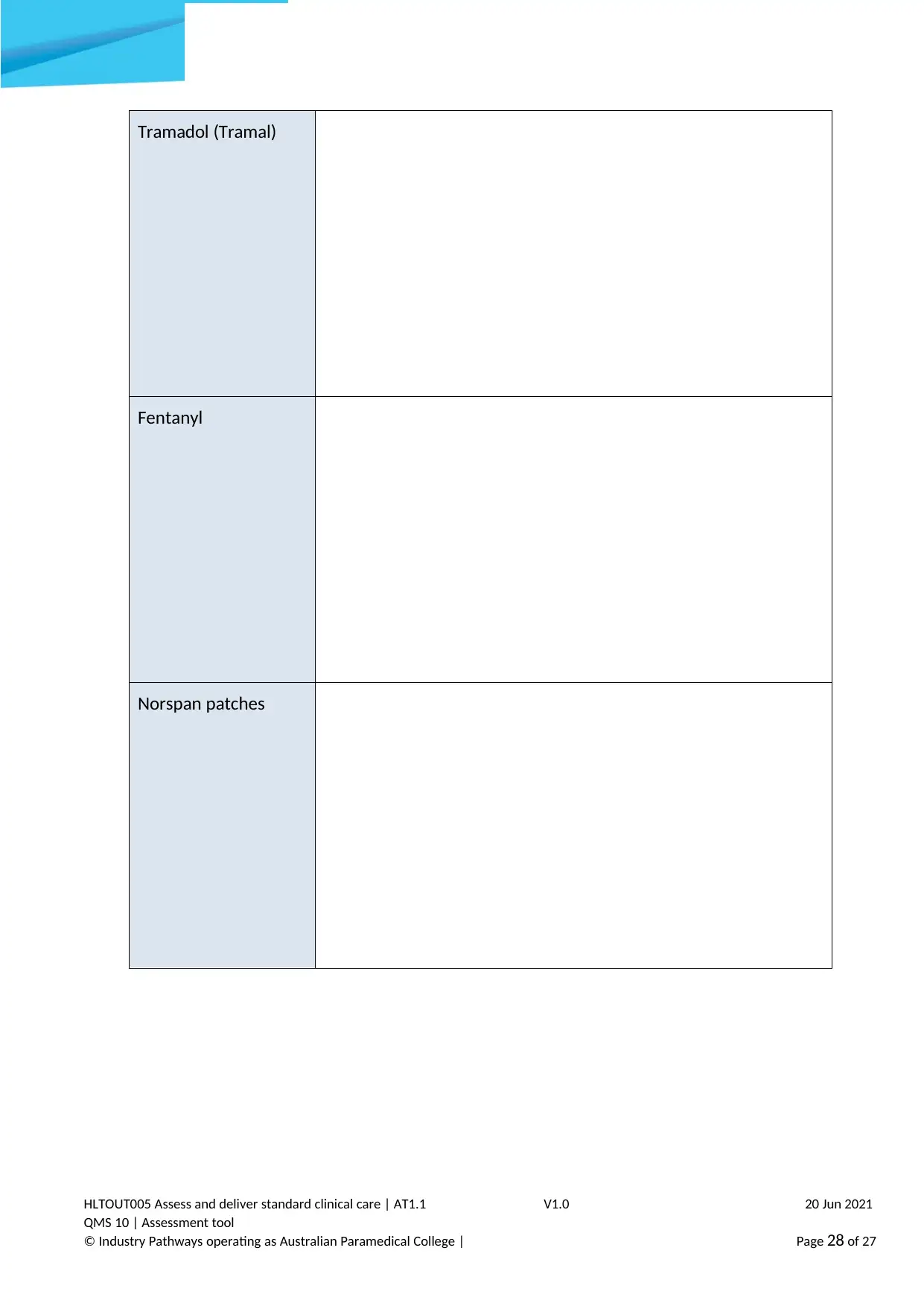
HLTOUT005 Assess and deliver standard clinical care | AT1.1
QMS 10 | Assessment tool
© Industry Pathways operating as Australian Paramedical College |
RTO32513
V1.0 20 Jun 2021
Page 28 of 27
Tramadol (Tramal)
Fentanyl
Norspan patches
QMS 10 | Assessment tool
© Industry Pathways operating as Australian Paramedical College |
RTO32513
V1.0 20 Jun 2021
Page 28 of 27
Tramadol (Tramal)
Fentanyl
Norspan patches
Secure Best Marks with AI Grader
Need help grading? Try our AI Grader for instant feedback on your assignments.
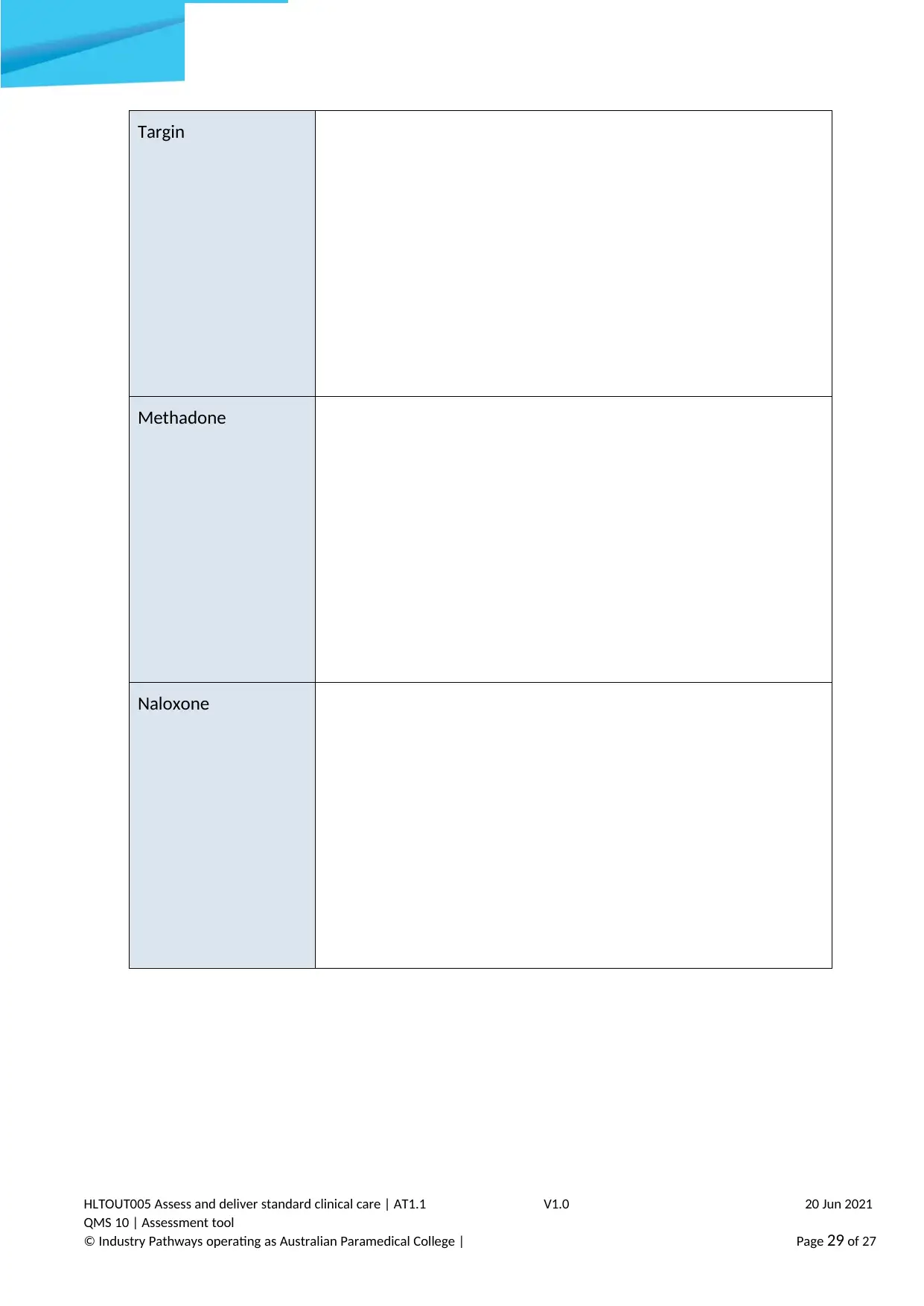
HLTOUT005 Assess and deliver standard clinical care | AT1.1
QMS 10 | Assessment tool
© Industry Pathways operating as Australian Paramedical College |
RTO32513
V1.0 20 Jun 2021
Page 29 of 27
Targin
Methadone
Naloxone
QMS 10 | Assessment tool
© Industry Pathways operating as Australian Paramedical College |
RTO32513
V1.0 20 Jun 2021
Page 29 of 27
Targin
Methadone
Naloxone
1 out of 29
Related Documents
Your All-in-One AI-Powered Toolkit for Academic Success.
+13062052269
info@desklib.com
Available 24*7 on WhatsApp / Email
![[object Object]](/_next/static/media/star-bottom.7253800d.svg)
Unlock your academic potential
© 2024 | Zucol Services PVT LTD | All rights reserved.





